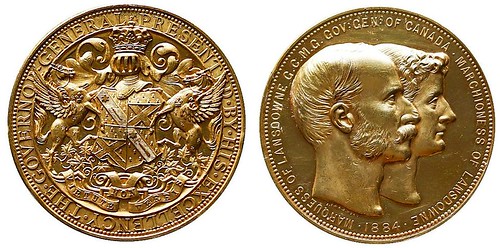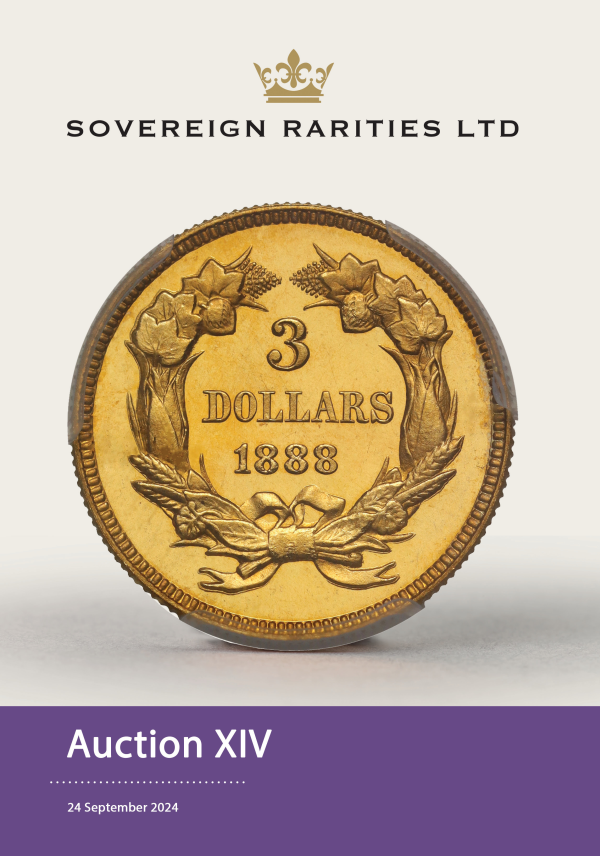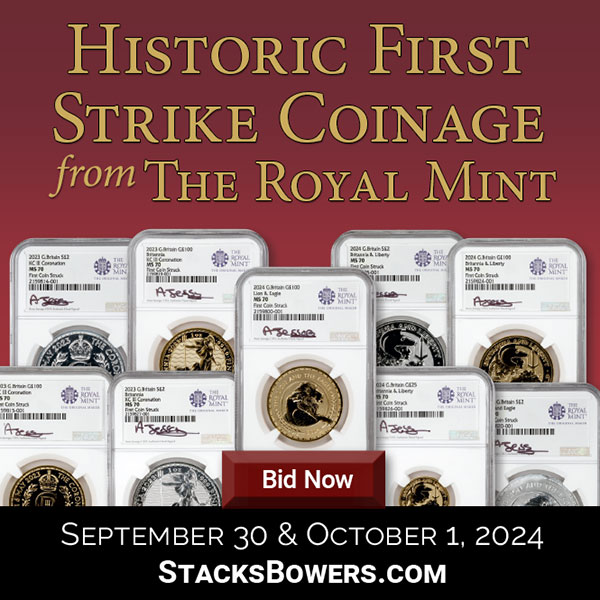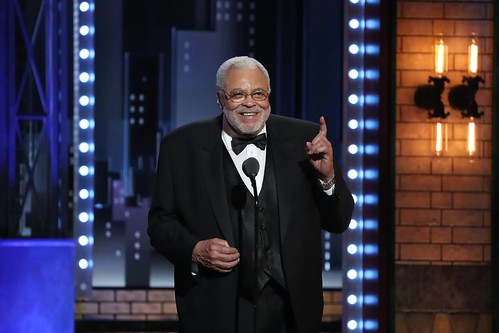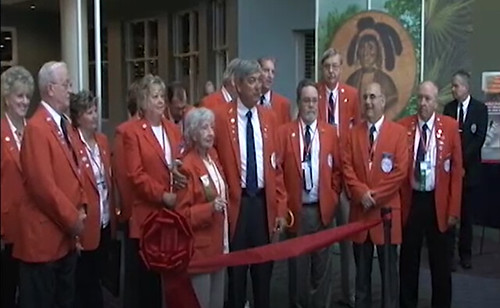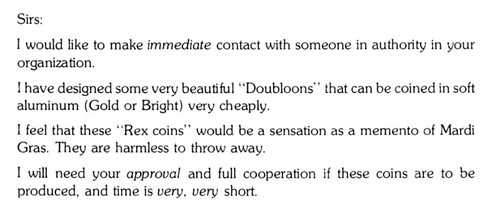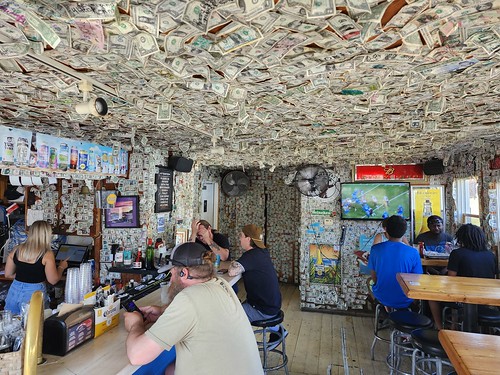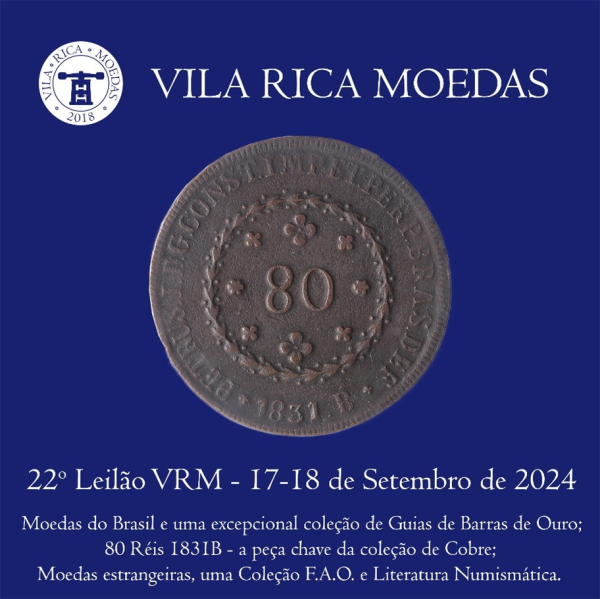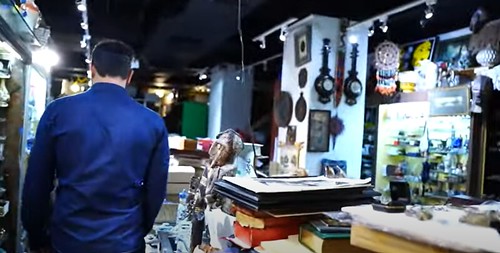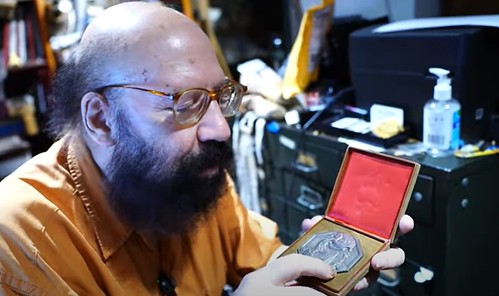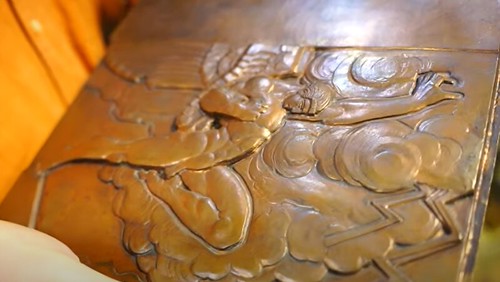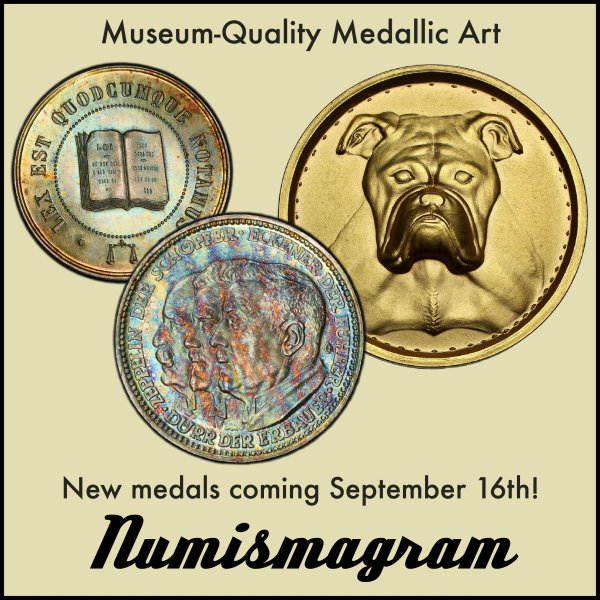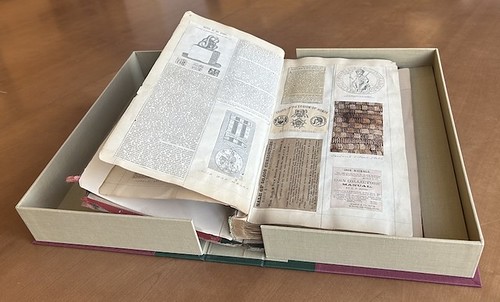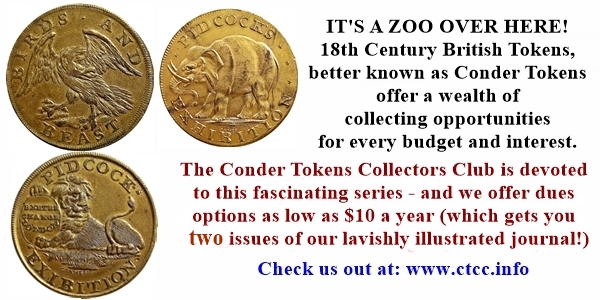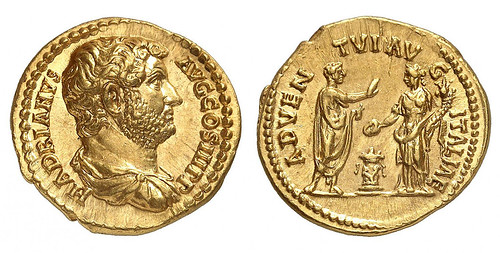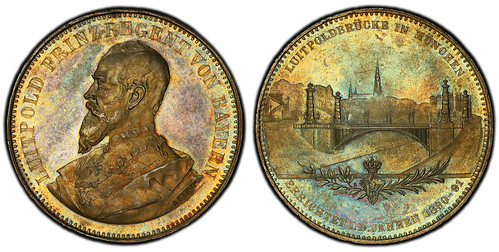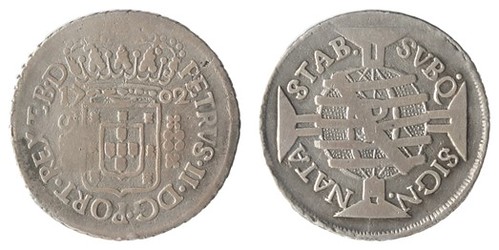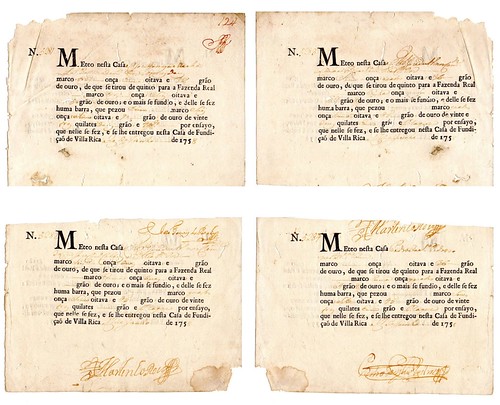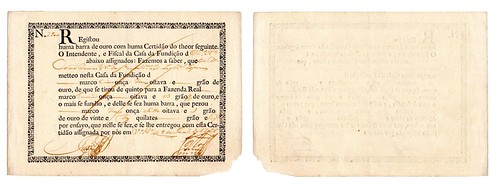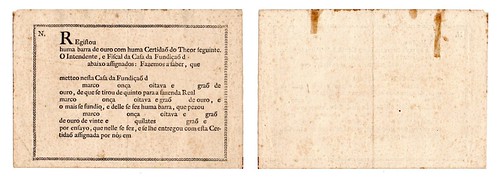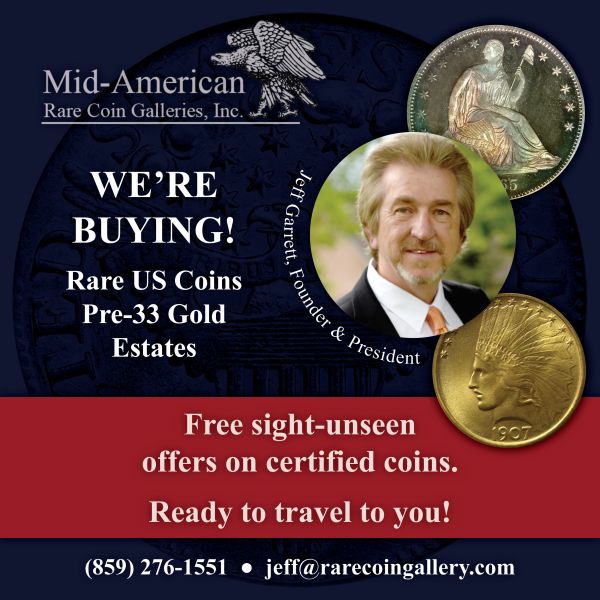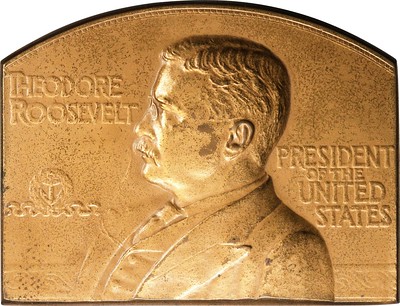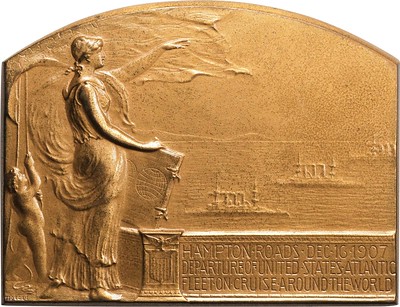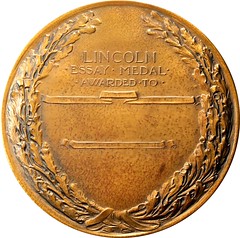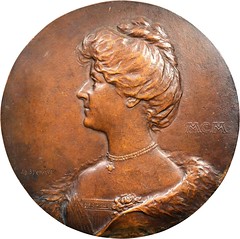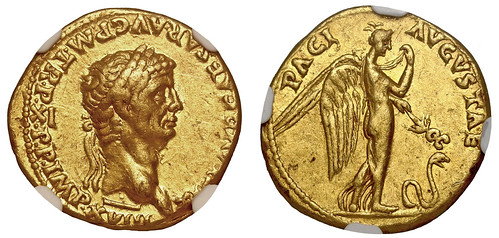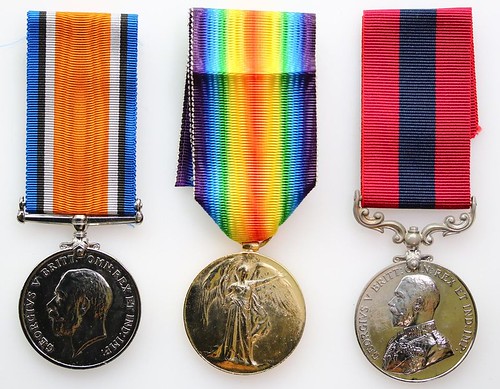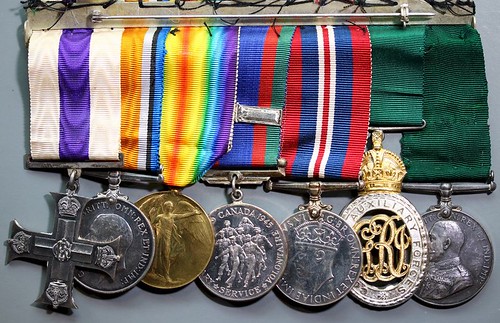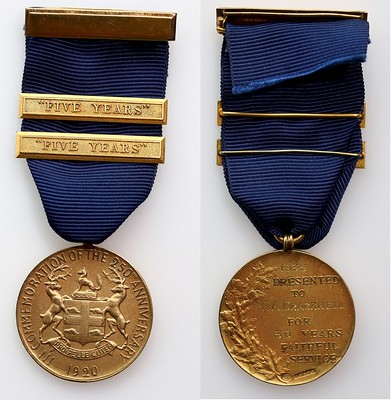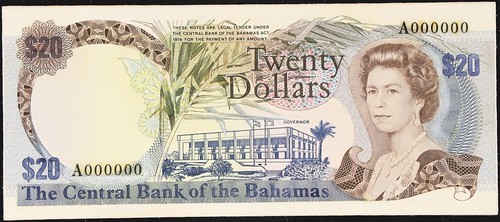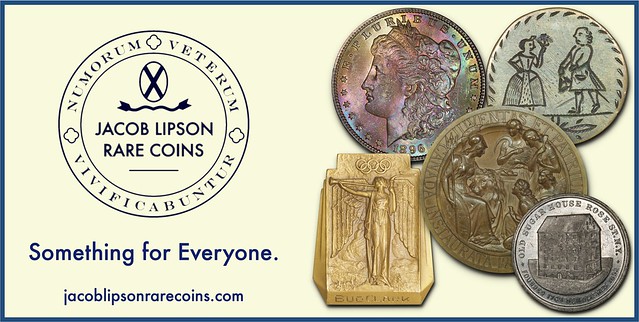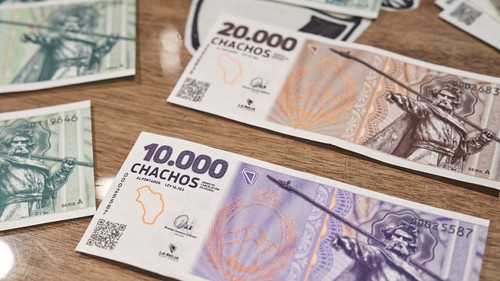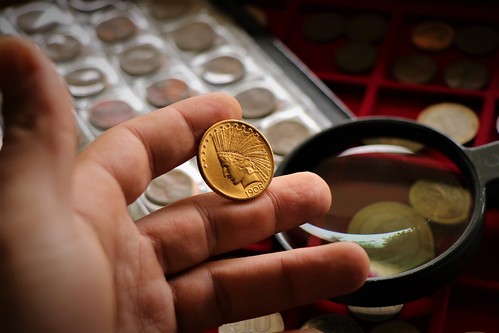
Visit our NBS Sponsors
About UsThe Numismatic Bibliomania Society is a non-profit association devoted to the study and enjoyment of numismatic literature. For more information please see our web site at coinbooks.org SubscriptionsThose wishing to become new E-Sylum subscribers (or wishing to Unsubscribe) can go to the following web page link MembershipThere is a membership application available on the web site Membership Application To join, print the application and return it with your check to the address printed on the application. Print/Digital membership is $40 to addresses in the U.S., and $60 elsewhere. A digital-only membership is available for $25. For those without web access, write to: Jeff Dickerson, Treasurer AsylumFor Asylum mailing address changes and other membership questions, contact Jeff at this email address: treasurer@coinbooks.org SubmissionsTo submit items for publication in The E-Sylum, write to the Editor at this address: whomren@gmail.com BUY THE BOOK BEFORE THE COINSale CalendarWatch here for updates! |
- WAYNE'S WORDS: THE E-SYLUM SEPTEMBER 15, 2024
- MUENZEN GUT-LYNT ONLINE AUCTION 18
- CUHAJ EBAY NUMISMATIC LITERATURE OFFERINGS
- NEW BOOK: COIN COLLECTING, 4TH EDITION
- NEW BOOK: CANADIAN COINAGE OF QUEEN ELIZABETH II
- NEW BOOK: CROATIAN BANKNOTES
- BANKNOTE BOOK NORTH VIETNAM CHAPTER PUBLISHED
- BOOK REVIEW: NEW JERSEY STATE COPPERS COMPANION
- JAMES EARL JONES (1931-2024)
- NNP: GREG BENNICK INTERVIEWS KELLEN HOARD
- VIDEO: 2009 FUN CONVENTION HIGHLIGHTS
- ON MARY BURLESON'S RETIREMENT
- MARDI GRAS DOUBLOON DETECTIVE WORK
- NOTES FROM E-SYLUM READERS: SEPTEMBER 15, 2024
- PAUL BOSCO IN ACTION
- ALFRED SANDHAM'S SCRAPBOOK
- APPLY TO THE CCAC!
- VOCABULARY TERM: PRIVATE MINT
- COIN COLUMNIST DANIEL WEBSTER (1932-2018)
- ATLAS NUMISMATICS SELECTIONS: SEPTEMBER 15, 2024
- VILA RICA MOEDAS AUCTION 22
- STACK'S BOWERS DICK JOHNSON MEDAL SELECTIONS
- CARLISLE-MINTED COIN OF DAVID I OF SCOTLAND
- LENHAM HOARD OF IRON AGE GOLD STATERS
- SOVEREIGN RARITIES AUCTION XIV
- TCNC 2024 MILITARIA & HISTORICAL MEDAL SALE
- STACK'S BOWERS 2024 MAASTRICHT AUCTION
- VIKING KING ATHELSTAN II SILVER PENNY FOUND
- ROWER'S FOUR OLYMPIC MEDALS STOLEN
- ARGENTINE PROVINCE LAUNCHES OWN CURRENCY
- JEFF GARRETT ON SHARING YOUR COLLECTION
- VIRGINIA SPORTS MEMORABILIA GOLD MINE
- LOOSE CHANGE: SEPTEMBER 15, 2024
Content presented in The E-Sylum is not necessarily researched or independently fact-checked, and views expressed do not necessarily represent those of the Numismatic Bibliomania Society.
WAYNE'S WORDS: THE E-SYLUM SEPTEMBER 15, 2024
 Thank you for reading The E-Sylum. If you enjoy it, please send me the email addresses of friends you think may enjoy it as well and I'll send them a subscription. Contact me at whomren@gmail.com anytime regarding your subscription, or questions, comments or suggestions about our content.
Thank you for reading The E-Sylum. If you enjoy it, please send me the email addresses of friends you think may enjoy it as well and I'll send them a subscription. Contact me at whomren@gmail.com anytime regarding your subscription, or questions, comments or suggestions about our content.
This week we open with two numismatic literature auctions, big and small, four new books, a review, updates from the Newman Numismatic Portal, notes from readers, and more.
Other topics this week include Canadian coinage, Croatian and North Vietnamese banknotes, James Earl Jones, Kellen Hoard, Mary Burleson, Paul Bosco, Mardi Gras doubloons, fixed price and auction offerings, Celtic gold staters, stolen Olympic medals, and an Argentine province's new currency.
To learn more about Bernt Ahlström, Fractional Currency, the Canadian coinage of Queen Elizabeth II, Labor Exchange scrip, Art Deco, Alfred Sandham, private mints, the Great White Fleet, the Tomb of Washington medal, the Pablo Picasso Visage Geometrique aux traits gold Medallion, the Marquess of Lansdowne medal, and painted die varieties, read on. Have a great week, everyone!
Wayne Homren
Editor, The E-Sylum
MUENZEN GUT-LYNT ONLINE AUCTION 18
Muenzen Gut-Lynt is offering the second part of the Bernt Ahlström numismatic library. Here's the announcement. -Editor
Saturday, 5 October 2024, starting at 3:00 pm (CET)
The Bernt Ahlström numismatic library, part 2
There will hardly be a dealer in the numismatic world who does not know the name Bernt Ahlström. When I picked up my first coins and books on coins and medals in Schleswig-Holstein in 1978, he was already a regular guest in the far north - bringing in consignments and, of course, stories.
And, at one of our last meetings in Zurich in 2019, Bernt Ahlström reviewed a few moments and highlights from his 60-year career - unfortunately, far too little of it has been recorded; he wrote nothing down. What remains is the memory of an outstanding numismatist, a dealer in several markets who could be found at all the important auctions, coin fairs and exhibitions. He was one of the first internationally active coin dealers: an exceptional personality; a numismatic "global player" as a dealer and auctioneer; a businessman with a feel for opportunities in the market and the courage to take these risks - and at his best "a giant in the world of coins", as one obituary put it.
In 1954 - at the age of just 18 - he opened the "B. Ahlström Mynthandel" in his native Stockholm on the initiative of his father. And at the legendary auction of the Farouk collection - organised by Sotheby's & Co in Cairo in February and March 1954 - he was one of the buyers of the Swedish part of this enormous coin collection. In the 1960s, he left Stockholm - his brother Bjarne continued to run the business there with great success - to establish the "Galerie des Monnaies" in Lausanne, Geneva and Düsseldorf in Switzerland and Germany.
The move "across the Atlantic" took place in the 1970s. Ahlström bought a former branch of Chase Manhattan Bank and opened an office in New York. He achieved world records at auctions and sales in collaboration with auction houses such as Hans Schulman Auctions, Sotheby's, Credit Suisse and Spink & Son. New York became a key milestone for him, and these years marked the peak of his numismatic success.
With his other brother John, he started Gallery des Vin in Paris, a vine shop and soon he bought a Bank there, "Crédit de la Bourse". But being the person, he was aiming a little bit too high, and the ideas in Paris fell apart. Later Ahlstrom moved to the US and partnered with Alcedo Almanzar, operating an auction house in the 1980s in El Dorado; Texas and closing his European business.
Another great passion for him was the Olympics. And being the universal genius that he was, he didn't just focus on medals and badges, but became a collector of all artefacts relating to the Olympics. When you visited him at home, you might suddenly find yourself standing in front of an original two-man bobsleigh sled, a torch, or the official uniform of the organisers, not to mention pennants, flags, or souvenirs. I guess only the museum in Lausanne has a larger selection.
Bernt Ahlström passed away in December 2019 after suffering from cancer. Up until his last week, he was still travelling and taking part in auctions.
(Arne Kirsch, March 2024)
-------------------------
The Gut-Lynt Coin Auction House is delighted to be able to offer the second part of the numismatic library of this illustrious and interesting "global player" on 5 October 2024. After the monographs - part 1 of the famous library, which were very successfully auctioned in April, over 1000 lots of auction catalogues from the last 200 years as well as further monographs will now be offered. This impressive series once again impressively demonstrates that Bernt Ahlström lived and loved numismatics in all its facets. A biography of the book lover and dealer Bernt Ahlström can be found on the company's website (www.gut-lynt.de/uber-bernt-ahlstrom).
The Gut-Lynt 18 online catalogue will be available on the auction platform www.auktionen.gut-lynt.de. Please don't forget to register in good time if you would like to bid for the first time. We accompany every auction with exclusive highlights on Instagram "muenzen_gut_lynt". Our website www.gut-lynt.de also offers previews and reviews as well as up-to-date information on auction dates and consignment deadlines.
If you have any questions about the Coins Gut-Lynt Auction 18, we will be happy to help you. simply write to info@gut-lynt.de or give us a call: (+49) 02156 4874819 We look forward to hearing from you.
CUHAJ EBAY NUMISMATIC LITERATURE OFFERINGS
George Cuhaj writes:
"Now that the Higgins Museum has closed for the season, I am back in Iola and selling books from the Krause Publications Library and other places. Of interest this week is a copy of D.W. Valentine's Fractional Currency publication of 1924 published by FCCC Boyd. Also some Ampersand auctions with printed prices realized and a early 1990s publication by Stack's on the 1783 Nova Constellatio coinage."
Thanks for letting us know. In addition to numismatic titles, there are works on railroads as well. -Editor
To see all of George's eBay offerings:
https://www.ebay.com/sch/i.html?item=356032878899&rt=nc&_trksid=p4429486.m3561.l161211&_ssn=cuhaj
NEW BOOK: COIN COLLECTING, 4TH EDITION
In a Greysheet News article, Whitman Publishing announced the fourth edition of the former Whitman Guide to Coin Collecting: An Introduction to the World of Coins, now retitled and rebranded under Whitman's new Collector Series. -Editor
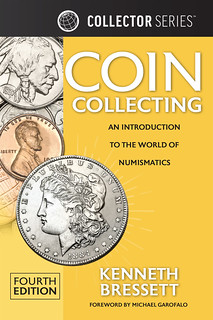 Attention, coin enthusiasts and collectors everywhere. Elevate your passion for numismatics with the highly anticipated fourth edition of Coin Collecting: An Introduction to the World of Numismatics, a comprehensive resource for everything coins and how to succeed in the world of coin collecting.
Attention, coin enthusiasts and collectors everywhere. Elevate your passion for numismatics with the highly anticipated fourth edition of Coin Collecting: An Introduction to the World of Numismatics, a comprehensive resource for everything coins and how to succeed in the world of coin collecting.
Author Kenneth Bressett, Editor Emeritus of A Guide Book of United States Coins (the Red Book), former president of the American Numismatic Association, and author of more than 20 numismatic books, has updated the definitive reference to finding just how lucky you can be as a coin collector.
Originally released in 1999 and referred to by the collecting community as the "Golden Book of Coin Collecting," or simply the Yellow Book, because of its easily identifiable color, Coin Collecting is one of Whitman's best-selling titles.
"Bressett's Coin Collecting is an evergreen in the Whitman library," said John Feigenbaum, President and CEO of Whitman Brands™. "It serves as an introduction for so many entering or navigating the hobby—rich in facts, insights, and tips on how to succeed in coin collecting. We hope this edition, with a new look, expanded content, and market values for popular coin series, generates even more interest."
Aimed squarely at newcomers to collecting but full of useful information for all levels, this is a guide that covers all the different aspects of coin collecting—how to get started in the hobby; what makes a coin valuable; where to buy and sell coins; how to care for and store your coins; understanding grading standards; oddities and counterfeits; gallery of actual coin sizes; plus coin-related collectibles and essential supplies—and in doing so brings a fun and potentially lucrative hobby home to readers everywhere.
"Coin Collecting is both well-designed and easy to follow, full of facts and replete with high-resolution photos for visual learners," said Diana Plattner, Whitman's Editorial Director. She added, "The book should appeal to both newcomers and experienced numismatists, distilling some very complex topics, and hopefully inspiring readers to continue learning via more specialized works."
Discover fresh chapters that delve into modern collecting strategies and embrace the excitement of building your collection with confidence. The all-new fourth edition features a revised chapter titled "Collecting with a Stated Purpose." Focused on the newcomer who is ready to start building a type-coin collection, it provides basic information and up-to-date market values using Greysheet-based pricing for the major types of U.S. circulating coinage from 1793 to date. Additionally, unlike previous editions, this edition is indexed with the type collector in mind, organized to help the reader who has taken an interest in one particular type across multiple denominations (e.g., Barber coinage, or the many variations on Bust coinage).
Foreword author Michael Garofalo emphasized, "Coin Collecting will help you begin your coin collecting journey and learn what is important. It truly is a ‘must have' when trying to find a good coin book that can help you get off on the right foot."
Formerly titled Whitman Guide to Coin Collecting: An Introduction to the World of Coins, this is the first title to be rebranded and published under Whitman's new Collector Series—your essential gateway into the fascinating world of collecting. The series provides comprehensive, up-to-date guidance on identifying, valuing, and caring for coins. Authored by industry experts, each book ensures enthusiasts can maximize both their enjoyment and their investment.
Coin Collecting is available for purchase online at Whitman.com, Whitman's Ebay Store, Amazon, and Walmart.com, and bookstores, hobby shops, and other retailers nationwide.
Great gift for family members, and for donation to local and school libraries. -Editor
For more information, or to order, see:
Coin Collecting: An Introduction To The World of Numismatics
(https://whitman.com/coin-collecting-an-introduction-to-the-world-of-numismatics/)
To read the complete article, see:
Whitman® Guide To Coin Collecting Gets A New Look And Feel: Introducing The All-new Fourth Edition
(https://www.greysheet.com/news/story/whitman-guide-to-coin-collecting-gets-a-new-look-and-feel-introducing-the-all-new-fourth-edition)
NEW BOOK: CANADIAN COINAGE OF QUEEN ELIZABETH II
With the passing of Queen Elizabeth II, the coinage of her long reign is complete. A new book catalogs the Canadian coinage featuring her portrait. -Editor
A Guide to Collecting the Canadian Coinage of Queen Elizabeth II
Christian Houle and
Serge Pelletier
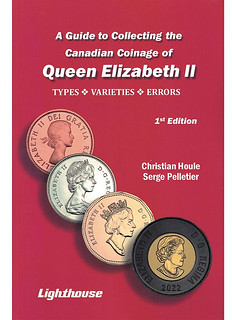 Discover a different, possibly more enjoyable way to collect the circulation coins of Queen Elizabeth II with this user-friendly guide.
Discover a different, possibly more enjoyable way to collect the circulation coins of Queen Elizabeth II with this user-friendly guide.
With it, you will discover all the changes that have undergone Canadian coin in the more than 70 years of Her Majesty's reign and how these can be represented by a few coins.
If you are sharp-eyed and enjoy details, large, high-resolution images will introduce you to the most popular varieties and how to distinguish one from another.
Finally, a section presents the various types of error with superb examples in high resolution, pointing out the way you can identify those errors.
1st Edition
Weight: .25 kg
Dimensions: 22.5 × 15 × 1 cm
$37.95
For more information, or to order, see:
A Guide to Collecting the Canadian Coinage of Queen Elizabeth II, 1st Edition
(https://coinstampsupplies.com/product/a-guide-to-collecting-the-canadian-coinage-of-queen-elizabeth-ii-1st-edition/)
NEW BOOK: CROATIAN BANKNOTES
If this sounds familiar, it's actually a new edition, this time translated from English to Croatian. -Editor
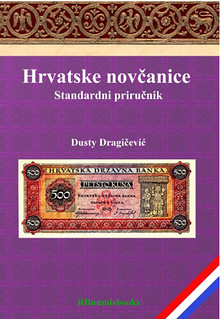 Dusty Dragicevic, an Australian-born Croatian, has just released the Croatian edition of his book, Croatian Banknotes: A Standard Reference.
Dusty Dragicevic, an Australian-born Croatian, has just released the Croatian edition of his book, Croatian Banknotes: A Standard Reference.
This book, which took 15 years to compile, offers a comprehensive exploration of Croatia's numismatic history, tracing the evolution of its currency from the days of the Independent State of Croatia to the present.
The English version has already attracted attention, and now, with the release of the Croatian edition, readers in Croatia can delve into the history of the Croatian banknote.
Dragicevic's connection to Croatia is strong. Born to a mother from Split and a father from Donji Humac on the island of Brac, Dusty grew up immersed in Croatian culture, language, and history.
His passion for Croatian numismatics began in 2001, during his first visit to Croatia after it became an independent nation. It was then that he first encountered Croatian banknotes, sparking a curiosity about the people, places, and history depicted on each note.
The result of Dragicevic's dedication is a 175-page softcover book, richly illustrated in full colour. Readers can learn about the origins of Croatia's famous symbols, discover the great individuals who shaped the nation's history, and explore every kuna issued since the introduction of the currency.
The book also includes a section on fantasy issues and even details the currency that Croatia almost adopted. This publication serves as a memorial catalogue, as Croatia has now transitioned to the Euro, marking the end of the kuna's era.
For those interested in meeting the author, Dusty Dragicevic will be appearing at the MIF Banknotes Fair in Maastricht on September 28th and 29th, where he will be meeting with his publisher, RB Numisbooks.
For more information, or to order, see:
Hrvatske novcanice, Standardni prirucnik, Dusty Dragicevic, Auflage 2024, Kroatische Version
(https://rbcurrency.com/p/hrvatske-novcanice-standardni-prirucnik-dusty-dragicevic-auflage-2024-kroatische-version)
Found via News & Notes from the Society of Paper Money Collectors (Volume X, Number 12, September 3, 2024). -Editor
To read the complete article, see:
Australian-Croat releases Croatian edition of Croatian banknotes history
(https://www.croatiaweek.com/australian-croat-releases-croatian-edition-of-croatian-banknotes-history/)
To read the earlier E-Sylum article, see:
NEW BOOK: CROATIAN BANKNOTES
(https://www.coinbooks.org/v25/esylum_v25n23a06.html)
BANKNOTE BOOK NORTH VIETNAM CHAPTER PUBLISHED
A new chapter of The Banknote Book by Mark Irwin and Owen Linzmayer has been published by CDN. -Editor
North Vietnam chapter now available
CDN is proud to announce the initial publication of the complete 16-page catalog covering notes issued from 1946 – 1959.
To read the complete article, see:
North Vietnam chapter now available
(https://banknotenews.com/?p=44991)
BOOK REVIEW: NEW JERSEY STATE COPPERS COMPANION
Dennis Wierzba is a member of the Colonial Coin Collectors Club (C4) publication Committee, and he submitted this note on their recently published book, New Jersey State Coppers Companion. Thank you. -Editor
REVIEW OF THE "NEW JERSEY STATE COPPERS
Companion"
by Roger S. Siboni, John L. Howes and
A. Buell Ish
 I had the privilege of reading this outstanding book, pre-publication.
The Companion supplements the original New Jersey State Coppers
book, but owning the first book is not a requirement as it is valuable in
its own right. The Companion makes two big contributions to collecting
NJ state coppers: an in-depth study of NJ painted die varieties (PDVs)
and a pictorial condition census of the private and auctioned great NJ
coppers collections—never seen before in one book. This is the first
pictorial census published by C4 and hopefully may lead to other future
pictorial CCs in different colonial series. As part of its educational
mission, this will be the fourteenth book published by C4.
I had the privilege of reading this outstanding book, pre-publication.
The Companion supplements the original New Jersey State Coppers
book, but owning the first book is not a requirement as it is valuable in
its own right. The Companion makes two big contributions to collecting
NJ state coppers: an in-depth study of NJ painted die varieties (PDVs)
and a pictorial condition census of the private and auctioned great NJ
coppers collections—never seen before in one book. This is the first
pictorial census published by C4 and hopefully may lead to other future
pictorial CCs in different colonial series. As part of its educational
mission, this will be the fourteenth book published by C4.
The late Robert Martin was the leading expert on PDVs and he shared his knowledge with the authors. Through studies of pedigree chains, it is possible to determine who made the painted annotation. In some cases, however, it might be an educated guess or maybe speculation. For some NJ copper collectors, this is a new area with the chance of forming a related subsidiary NJ collection.
The question of what is a true condition census NJ copper can be answered by comparing a prospective coin versus the pictures, not just relying on the slab grade. The fact that these outstanding coins are documented in one place in 2024 is a gift to future generations of collectors.
Colonial coppers have their individuality—they are not uncirculated Morgan dollars. The pictorial CC will allow the astute NJ collector to make their own judgments.
I predict strong sales of the Companion for the hottest area of colonial collecting—NJ coppers.
Thank you. For background, here's an excerpt from an article by Stack's Bowers Numismatist Chris Bulfinch about Painted Die Varieties. -Editor
In the past, collectors of colonial and pre-federal coinage would paint or otherwise hand write die variety attribution numbers on their coins. Evidence of the practice, considered taboo by collectors today, can be seen on many pre-federal coins. These are known as PDVs (Painted Die Varieties).
Ray Williams, former president of the Colonial Coin Collectors Club and an expert on Confederation-era state coinage, authored an article on PDVs for the March 2024 issue of The Numismatist that lays out the rationale for the painting. Collectors who stored coins in cabinets understood that if a tray from a cabinet was dropped and coins were separated from their identification tags, "All [their] attribution work would be for naught, and it would take possibly days or weeks to reattribute the coins." Thus, they chose to record the variety in a way that couldn't be separated from the coin!
Using ink, usually white or another light color (occasionally black ink or pencil was used), collectors hand-wrote variety attribution numbers on their coins. The practice came into vogue, per Williams, as the first serious efforts at cataloging pre-federal coinage by die variety were being published, from the mid-19th century to the early 20th
To read the complete article, see:
Did You Know That In the 19th Century Some Early American Copper Collectors Would Hand-Write Variety Attributions on Their Coins
(https://stacksbowers.com/did-you-know-that-in-the-19th-century-some-early-american-copper-collectors-would-hand-write-variety-attributions-on-their-coins/)
To read the earlier E-Sylum article, see:
NEW BOOK: NEW JERSEY STATE COPPERS COMPANION
(https://www.coinbooks.org/v27/esylum_v27n36a04.html)
JAMES EARL JONES (1931-2024)
Why does the late actor James Earl Jones appear in this issue? The voice of the evil Darth Vader of Star Wars was also a coin collector who bought from West Coast dealers (and at the Long Beach shows) and helped the hobby by narrating the "Money: History In Your Hands" program. He also collected the National Medal of the Arts from President George Bush at the White House in 1992. -Editor
James Earl Jones, a stuttering farm child who became a voice of rolling thunder as one of America's most versatile actors in a stage, film and television career that plumbed race relations, Shakespeare's rhapsodic tragedies and the faceless menace of Darth Vader, died on Monday at his home in Dutchess County, N.Y. He was 93.
From destitute days working in a diner and living in a $19-a-month cold-water flat, Mr. Jones climbed to Broadway and Hollywood stardom with talent, drive and remarkable vocal cords. He was abandoned as a child by his parents, raised by a racist grandmother and mute for years in his stutterer's shame, but he learned to speak again with a herculean will. All had much to do with his success.
So did plays by Howard Sackler and August Wilson that let a young actor explore racial hatred in the national experience; television soap operas that boldly cast a Black man as a doctor in the 1960s; and a decision by George Lucas, the creator of "Star Wars," to put an anonymous, rumbling African American voice behind the grotesque mask of the galactic villain Vader.
Under the artistic and competitive demands of daily stage work and heavy commitments to television and Hollywood — pressures that burn out many actors — Mr. Jones was a rock. He once appeared in 18 plays in 30 months. He often made a half-dozen films a year, in addition to his television work. And he did it for a half-century, giving thousands of performances that captivated audiences, moviegoers and critics.
James Earl Jones was born in Arkabutla, Miss., on Jan. 17, 1931, to Robert Earl and Ruth (Connolly) Jones. About the time of his birth, his father left the family to chase prizefighting and acting dreams. His mother eventually obtained a divorce. But when James was 5 or 6, his frequently absent mother remarried, moved away and left him to be raised by her parents, John and Maggie Connolly, on a farm near Dublin, Mich.
Mr. Jones enrolled at the University of Michigan on a scholarship, taking pre-med courses, and joined a drama group. With a growing interest in acting, he switched majors and focused on drama in the university's School of Music, Theater and Dance. In a memoir, he said he left college in 1953 without a degree but resumed studies later to finish his required course work. He received a degree in drama in 1955.
In college, he had also joined the Army under an R.O.T.C. commitment, then washed out of infantry Ranger School. But he did so well in cold-weather training in the Rockies that he considered a military career. He was commissioned a second lieutenant in mid-1953, after the end of the Korean War, and was subsequently promoted to first lieutenant.
In 1955, however, he resigned his commission and moved to New York, determined to be an actor. He lived briefly with his father, whom he had met a few years earlier. Robert Jones had a modest acting career and offered encouragement. James found cheap rooms on the Lower East Side of Manhattan, took odd jobs and studied at the American Theater Wing and Lee Strasberg's Actors Studio.
To read the complete article, see:
James Earl Jones, Whose Powerful Acting Resonated Onstage and Onscreen, Dies at 93
(https://www.nytimes.com/2024/09/09/arts/james-earl-jones-dead.html)
Here's our earlier article on the "Money: History in Your Hands" video. -Editor
The award-winning educational video, "Money: History in Your Hands," narrated by acclaimed actor James Earl Jones, now is available for free viewing on the Professional Numismatists Guild YouTube.com channel.
"We currently have more than a dozen videos about rare coins, paper money and precious metals available for complimentary viewing on PNG's YouTube channel. They will be helpful for beginners to advanced collectors and investors with informative advice about buying, storing and selling numismatic items as well as gold, silver and platinum bullion items," said PNG Executive Director Robert Brueggeman.
"An important part of our educational effort is the video, ‘Money: History in Your Hands,' jointly created by PNG and the American Numismatic Association, and hosted on camera by James Earl Jones. It gives viewers a compelling overview of the history of money, and how it relates to art, culture, history, politics and religion," explained Brueggeman. "The 29-minute video is available for convenient viewing in two parts."
Other informative PNG videos focus on topics of discovering the enjoyment of
coin collecting, how to determine the value of your coins, and the importance of working
with a reputable, knowledgeable dealer when you buy or sell.
All of the videos are can be viewed at:
https://www.youtube.com/channel/UCb5co6ZLKPitRAw-6pDxeCw
If you have a numismatic web site or email list, consider linking to and promoting the videos.
While the PNG YouTube channel is brand new, the Jones videos are not. I reached out to PNG Public Relations contact Donn Pearlman for more information. -Editor
Donn Pearlman writes:
This is the same "Money: History In Your Hands" program that was shown on many PBS TV stations some years ago. I was involved in getting it distributed nationwide and placed through WTTW-TV in Chicago. I also wrote the script for the original video.
I had already started about four or five pages of script when I was informed that James Earl Jones had agreed to be the on-camera host and do the voice-over narration. I immediately ripped up my initial writing and started again with his voice in my head.
I completely rewrote the video's opening segment so that viewers would see a montage of different kinds of money and hear Mr. Jones voice reading a list of slang terms for money. His final word is, "Moola."
Here are direct links to the videos. -Editor
Part I
James Earl Jones guides you through a numismatic history lesson illustrating the coins and lives of Jesus Christ, Julius Caesar, Alexander the Great, Abraham Lincoln, Hercules and Daniel Boone.
Part II
James Earl Jones picks up the fascinating history of money with the American Civil War, leading up to modern times with some of our favorite, and most controversial, U.S. coins and currency. The video also touches on precious metal bullion, coin values and most importantly, how to collect coins.
To watch the videos, see:
Money: History in Your Hands - Part I
(https://www.youtube.com/watch?v=Ir_oCtaXloc&t=191s)
Money: History in Your Hands - Part II
(https://www.youtube.com/watch?v=gb3mgkYMssM)
To read the earlier E-Sylum article, see:
PNG ADDS JAMES EARL JONES COLLECTING VIDEOS
(https://www.coinbooks.org/v20/esylum_v20n22a11.html)
NNP: GREG BENNICK INTERVIEWS KELLEN HOARD
The latest addition to the Newman Numismatic Portal is CCAC member Kellen Hoard. Project Coordinator Len Augsburger provided the following report. -Editor
Greg Bennick Interviews Kellen Hoard
 In his continuing series of numismatic interviews, Greg Bennick (virtually) sits down with Kellen Hoard, who was named Young Numismatist of the Year by the American Numismatic Association in 2021 and is currently a student at George Washington University. He serves on the Citizens Coinage Advisory Committee (CCAC) and writes a regular column for The Numismatist.
In his continuing series of numismatic interviews, Greg Bennick (virtually) sits down with Kellen Hoard, who was named Young Numismatist of the Year by the American Numismatic Association in 2021 and is currently a student at George Washington University. He serves on the Citizens Coinage Advisory Committee (CCAC) and writes a regular column for The Numismatist.
Hoard touches on how he got started with numismatics, sharing numismatics with people outside the hobby, and his engagement with journalism, politics, public policy, and international affairs. Kellen provides context on the end-end workflow of the CCAC and evolution of coinage from legislation to production. Hoard wraps up with an optimistic view of the next generation of numismatists.
 Greg Bennick is a longtime numismatist and serves on the board of the Combined Organization of Numismatic Error Collectors of America (CONECA). He recently published Reclaim the Moment: Seven Strategies to Build a Better Now (Wiley, 2024), which ranked recently as high as #2 on Amazon's list of Business Management books.
Greg Bennick is a longtime numismatist and serves on the board of the Combined Organization of Numismatic Error Collectors of America (CONECA). He recently published Reclaim the Moment: Seven Strategies to Build a Better Now (Wiley, 2024), which ranked recently as high as #2 on Amazon's list of Business Management books.
Link to Kellen Hoard interview on YouTube:
https://youtu.be/tBb-Bt4NR8k
Link to transcript of Kellen Hoard interview:
https://nnp.wustl.edu/library/book/641580
Link to Greg Bennick interviews on Newman Portal:
https://nnp.wustl.edu/library/multimediadetail/548505
s
VIDEO: 2009 FUN CONVENTION HIGHLIGHTS
The David Lisot Video Library on the Newman Numismatic Portal can be found at:
https://nnp.wustl.edu/library/multimediadetail/522852
We highlight one of his videos each week in The E-Sylum. Here's one from 2009 filmed at the FUN Convention. -Editor
Hear and see FUN President, Bob Hurst, give the opening speech to introduce the 2009 Orlando convention. See the usual parade of dignitaries on the podium, the awards given and the ribbon cutting. Then we venture out on the bourse floor where you will meet new PCGS President, Don Willis, ANA Presidential candidate, Clifford Mishler, coin dealers Wayne Herndon and David Gotkin, and large cent collector Dan Holmes.
Speaker(s): Bob Hurst, FUN President.
To watch the complete video, see:
FUN Convention Highlights 2009
(https://nnp.wustl.edu/library/book/560299)
ON MARY BURLESON'S RETIREMENT
Dennis Tucker provided these thoughts on the recent retirement of his longtime Whitman Publishing colleague Mary Burleson. -Editor
On Mary Burleson's Retirement
In December 2004, I faced a challenging but very welcome professional choice. I'd recently turned thirty-two and, after building a solid career in writing, editing, and publications management, two exciting new job offers were on my plate. One was directing corporate communications for Coca-Cola North America. The other was the position of publisher at the newly invigorated Whitman Publishing, LLC.
The Coca-Cola position would have been a feather in my professional cap and an amazing opportunity with a global company. In a world unrelated to soft drinks and bottled water, the Whitman position was much the same. I couldn't resist its lure, and it was the iconic publishing company that made my final cut.
 An important factor in my decision was Whitman president Mary Burleson (at that time, Mary Counts). Atlanta-based Anderson Press had purchased Whitman from St. Martin's in 2003. Mary had been crucial in encouraging Q. David Bowers to sign on as the company's numismatic director. I remember my first interview with Mary. She described her vision for the company's future. Dave Bowers would be fundamental to the firm's success. Whitman would also continue and grow its collaboration with Kenneth Bressett and other longtime authors, while developing a new generation of numismatic writers and researchers, including Jeff Garrett, who was already tapped for several books. I could tell that Mary was driven, focused, and creative, and she saw a bright future for this strong and energetic new Whitman Publishing. I've jokingly said that when I came on board in December 2004, Whitman was a folder-and-album company that happened to publish a few books. Mary Counts and the team she was building would usher in a twenty-plus-year renaissance in numismatic publishing.
An important factor in my decision was Whitman president Mary Burleson (at that time, Mary Counts). Atlanta-based Anderson Press had purchased Whitman from St. Martin's in 2003. Mary had been crucial in encouraging Q. David Bowers to sign on as the company's numismatic director. I remember my first interview with Mary. She described her vision for the company's future. Dave Bowers would be fundamental to the firm's success. Whitman would also continue and grow its collaboration with Kenneth Bressett and other longtime authors, while developing a new generation of numismatic writers and researchers, including Jeff Garrett, who was already tapped for several books. I could tell that Mary was driven, focused, and creative, and she saw a bright future for this strong and energetic new Whitman Publishing. I've jokingly said that when I came on board in December 2004, Whitman was a folder-and-album company that happened to publish a few books. Mary Counts and the team she was building would usher in a twenty-plus-year renaissance in numismatic publishing.
Mary had earned the trust of the leadership of the Anderson family of businesses, headed by brothers Charles and Joel Anderson. Over the course of our long collaboration as "Whitmanites" (as Dave Bowers affectionately called us), I saw Mary helping the entire span of Anderson companies—not just Whitman, but also Sonrisas, Piggy Toes, Dalmatian Press, and other publishing firms and imprints; home-goods retailer Burnes of Boston; Tutu Couture; TNT Fireworks, and many others. She helped coordinate acquisitions. She went around the country and even overseas to inspect production factories. She opened new offices. She was tireless, and her work wasn't just high-level management—during Red Book crunch time, she would be in the trenches cross-checking spreadsheets and proofreading laid-out pages with everyone else.
Mary's energy, talent, and business savvy, and the deep trust and admiration she's earned from those who work with her, make me think of Longfellow's "The Ladder of Saint Augustine." "The heights by great men reached and kept," wrote the poet, "Were not attained by sudden flight, But they, while their companions slept, Were toiling upward in the night."
For years, Mary Burleson has inspired hundreds of co-workers, not to mention thousands of people in the hobby community. She's a dynamo—and she's modest, so I know she'd be embarrassed to read this praise, but she deserves every word of it. I wish her the best always!
Thanks, Dennis. I think "dynamo" is a perfect word to describe Mary. Her accomplishments are many and amazing. The hobby owes her a debt of gratitude for the company's prolific output of important and useful numismatic titles, all of which have helped propel the hobby and business to new heights. Good luck in your new career stage, Mary! -Editor
To read earlier E-Sylum articles, see:
WHITMAN PUBLISHER DENNIS TUCKER RETIRING
(https://www.coinbooks.org/v27/esylum_v27n06a07.html)
WHITMAN PUBLISHING PRESIDENT MARY BURLESON RETIRES
(https://www.coinbooks.org/v27/esylum_v27n36a20.html)
MARDI GRAS DOUBLOON DETECTIVE WORK
In looking for a contemporary account of the story of H. Alvin Sharpe throwing a handful of his prototype lightweight Mardi Gras doubloons at the Captain of Rex, Pete Smith found a newspaper account from 1966. Julia Casey was able to locate an earlier story from the New Orleans Times-Picayune January 31,1965. Thanks. -Editor
H. Alvin Sharpe stood before the Captain of Rex on a fateful day in 1959.
"Throw it at me," said the Captain of Rex, whose identity, in keeping with Mardi Gras tradition, must remain secret.
Sharpe sailed a light aluminum coin at the Captain. The coin struck him, but didn't hurt.
"I'll buy that even if I have to go into my own pocket," said the Captain of Rex. "That is what we've been looking for."
Earlier this week, the Captain of Rex was talking about the doubloon which has revolutionized Mardi Gras. "We'd been thinking about changing mementos," said the Captain.
"We wanted something the crowd could keep better than beads or throws. So the Sharpe idea was the answer to our search."
Dave Schenkman asked:
"Have you seen the book Carnival Panorama which was published in 1966?"
I confessed to being unsure - I may have had the book in my library at one point, but I'm unable to locate it now. Dave kindly offered to bring his copy to our Nummis Nova dinner next week. Meanwhile, John Byars passed along a Google Books version of Leonard V. Huber's 1977 Mardi Gras: A Pictorial History of Carnival in New Orleans which takes the story back to Sharpe's December 5, 1959 letter. -Editor
The Huber book states that a meeting was arranged and Sharpe "... presented his design and demonstrated how a light aluminum medallion could be thrown from the floats without injuring anyone. Impressed with the idea, the Rex captain immediately arranged to underwrite the first issue of the Rex doubloon. Alvin Sharpe went speedily to work to engrave the dies, strike off 83,000 doubloons, 80,000 in natural aluminum finish and 3,000 in gold anodized finish, and deliver them to the Rex den several weeks before Mardi Gras, which fell on March 1. Instant favor with the crowd was won. The traditional cry, "Hey mister, throw me something," became "Hey mister, throw me a doubloon!"
So there are different accounts of exactly how the doubloons' safety was demonstrated. Did Sharpe throw a handful, one or none? But safety was indeed demonstrated and the decision made. Thanks, everyone. -Editor
To read the complete articles, see:
NOTES FROM E-SYLUM READERS: SEPTEMBER 1, 2024 : Mardi Gras Doubloons and H. Alvin Sharpe
(https://www.coinbooks.org/v27/esylum_v27n35a10.html)
NOTES FROM E-SYLUM READERS: SEPTEMBER 8, 2024 : Doubloon Documentation Drought
(https://www.coinbooks.org/v27/esylum_v27n36a12.html)
NOTES FROM E-SYLUM READERS: SEPTEMBER 15, 2024
Ship Shilling = Cost of Christian Burial
Kavan Ratnatunga writes:
"I read with interest in the E-Sylum, the association of the Ship Shilling with Warships. This might be why the Lakdiva Holland Scheepjes-Schellings is holed which is typical for many of them. They were worn on a chain around the neck by many Sailors. According to Late Mr Fred Medis, a Schelling or 6 Stuivers was the cost of Christian Burial in the 17th and 18th centuries. If the Sailor was lost at sea and the body washed ashore the finder was expected to give a proper Burial and keep the Schelling as payment."
Interesting! Thank you. -Editor
To read the page on Kavan's website, see:
Netherlands, Holland: 1671-1767
Silver Scheepjes-Schelling
(https://coins.lakdiva.org.lk/netherlands/1724_hol_scheep_6s_ag.html
)
To read the earlier E-Sylum article, see:
THE LITTLE SHIP SHILLING
(https://www.coinbooks.org/v27/esylum_v27n36a27.html)
Unique Labor Exchange Scrip Design?
Dave Lewis writes:
"A year ago I sent you a previously unknown Daunt, California Labor Exchange Scrip.
"Recently I obtained a Labor Exchange Scrip from Manistee, Michigan (Branch #233) which I believe may be the only such Labor Exchange design and perhaps the latest Labor Exchange Scrip produced.
"It's a 1/100th Manistee, Michigan (Branch #233) Scrip dated 1900. I assume it probably was locally printed as in 1900 there may not have been any of the common scrip notes available. The reverse is also location specific and refers to the Labor Exchange office at 310 Oak Street in Manistee. At this time this property was a simple house owned by Henry Pallman, who signed the scrip on the lower left.
"If you have ever seen such a design or other similar scrip, please let me know."
Very interesting. I was also unfamiliar with this design. Can anyone help? -Editor
To read the earlier E-Sylum article, see:
DAUNT, CALIFORNIA LABOR EXCHANGE SCRIP
(https://www.coinbooks.org/v26/esylum_v26n34a17.html)
More on Arno Safran
Ray Wiliams writes:
 "I always enjoy reading the E-Sylum each week. Reading the interview of Arno Safran brought back memories. Arno was a numismatic presence in NJ back in the day. The Augusta Coin Club's gain is New Jersey's loss! Arno was a member of a number of local clubs - Trenton Numismatic Club (TNC), Ocean County Coin Club (OCCC), New Jersey Numismatic Society NJNS) and others I'm sure. He was an officer and editor for these clubs and the state organization - the Garden State Numismatic Association.
"I always enjoy reading the E-Sylum each week. Reading the interview of Arno Safran brought back memories. Arno was a numismatic presence in NJ back in the day. The Augusta Coin Club's gain is New Jersey's loss! Arno was a member of a number of local clubs - Trenton Numismatic Club (TNC), Ocean County Coin Club (OCCC), New Jersey Numismatic Society NJNS) and others I'm sure. He was an officer and editor for these clubs and the state organization - the Garden State Numismatic Association.
"Arno was giving presentations and writing for numismatic publications when I met him at the TNC in the 1980s. He invited me to attend one of the NJNS meetings in Madison, NJ. On the drive home, I told him that the members were so advanced, many authors and experts in their fields, and that I felt out of place. He encouraged me to join and reassured me that I'd be in good company. His encouragement and willingness to share his knowledge has inspired me to try to do the same. I wonder how many collectors across the country have been inspired by him..."
To read the earlier E-Sylum article, see:
NNP GREG BENNICK INTERVIEWS ARNO SAFRAN
(https://www.coinbooks.org/v27/esylum_v27n35a07.html)
NCLT Banknote Question
Kavan Ratnatunga writes:
"Limited issue of Non circulating Legal Tender (NCLT) coins minted with precious metals are common. However, it is rare, as banknotes. A webpage on the Cayman Islands Monetary Authority site states, "The $70 banknote, limited to a production of only 10,000 units, will remain exclusive and will not enter general circulation."
"Is this the first very low-number printed "NCLT" commemorative Banknote issue for the numismatic collector market?
"First issued in 2023 October they are selling on eBay for over 5 times their face value of US$86 in less than a year."
Interesting question, although other countries have produced commemorative banknotes, they may not be legally noncirculating. -Editor
To read the webpage, see:
Her Late Majesty Queen Elizabeth II $70 Commemorative Banknote
(https://www.cima.ky/her-late-majesty-queen-elizabeth-ii-70-commemorative-banknote)
Captain Lou's in South Haven, Michigan
Len Augsburger writes:
"In the "bars with currency as wallpaper" department comes Captain Lou's in South Haven, MI."
"Here, Joel Orosz studies the Captain Lou's menu.
"The waitress later reported that they are tearing down the building soon, with the currency to be donated to charity."
It's great to get reports from the road from NBS officers. Len is our current President, and Joel of Kalamazoo, MI is our Historian. Bottom's up! -Editor
PAUL BOSCO IN ACTION
Dealer Paul Bosco of New York City writes:
"My next-door neighbor (Adam Weinberger), here in the antiques center, a top dealer in rare books, did a YouTube video of me in action. 7500 views in a week!
"At one point, I state that I have the highest profit margin in the industry. (This is true.) What got edited out was: "I also have the slowest turn-around in the biz, and I have no one imitating my modus operandi.""
Check it out, and if you're visiting the city, stop in to Paul's palace of antique wonders, where great medals are the icing on the cake for collectors of all stripes. -Editor
To watch the video, see:
PAUL BOSCO IN THE GREATEST ANTIQUE CENTER IN THE WORLD
(https://www.youtube.com/watch?v=MQhLOzNe49Q)
ALFRED SANDHAM'S SCRAPBOOK
This article from the American Numismatic Society's Pocket Change blog, written by David Hill, covers an intriguing recent addition to the ANS library. -Garrett
One of the more interesting items we've gotten in the ANS Library recently is a scrapbook assembled by pioneering Canadian numismatist Alfred (Alf) Sandham in the 1800s. Filled with clippings, photographs, circulars, sketches, and other fascinating numismatic ephemera, it was donated by ANS fellow David Fanning, who had a special clamshell box made to protect it.
Sandham joined Montreal's numismatic society in 1865, becoming perhaps its most important and active member. Founded in 1862, four years after the ANS, it was among the first handful of such groups in the western hemisphere. Sandham worked to put it on solid footing and was primarily responsible for issuing its first medal, commemorating its incorporation in 1870, which Sandham helped bring about.
Sandham joined the ANS in 1867, sending in a picture of himself. That year we also find the first of a handful of letters he would send over the decades. In it he sympathizes with the publishers of the ANS's recently launched American Journal of Numismatics, having learned that "financially" it was already a failure. He said he considered it "editorially a success." At the time, Canada was in a state of flux, its three provinces being united in a self-governing dominion, and the political changes were having an effect on coinage. Sandham noted that "coins which a year or so ago were met with almost every day are now hard to be procured." Anticipating their replacement by a national coinage of a confederated Canada, he offered to send specimens for the ANS cabinet, the subsequent receipt of which were duly logged in the Society's accession book. Of course, he also donated coins to the Montreal society, noting these on a list pasted into the scrapbook.
In 1871 he sent the ANS a copy of his privately printed Medals Commemorative of the Visit of H.R.H. the Prince of Wales to Montreal, one of the first photographically illustrated numismatic books, noting that he printed only 50 of these for his friends and had just four or five left. Sandham continued to send his other publications to the Society over the next few years, but in an 1875 letter he announced that he had "completed [his] labors in the numismatic and literary line" and had decided to "retire" from it, devoting his time to other interests. He sold his coin collections in various sales, the last of which was in 1884. Sandham remained a corresponding member of the ANS throughout his life, but admitted, in the last letter we have from him in 1898, that "I am not a very active student of numismatics." Sandham died at age 72 in 1910.
To read the complete article, see:
Alfred Sandham's Scrapbook
(https://numismatics.org/pocketchange/alfred-sandhams-scrapbook/)
APPLY TO THE CCAC!
The Citizens Coinage Advisory Committee (CCAC) has an opening for a member representing the public. Apply now! Here's the announcement. -Garrett
The United States Mint is seeking applicants for appointment to the Citizens Coinage Advisory Committee (CCAC) as a member representing the interests of the general public. The deadline to email submissions is no later than 5 p.m. (ET) on Friday, October 18, 2024. The United States Mint will review all applications and will forward recommendations to the Secretary of the Treasury for consideration.
The CCAC is composed of 11 members — one specially qualified in numismatic collection curation; one specially qualified in the medallic arts or sculpture; one specially qualified in American history; one specially qualified in numismatics; three individuals appointed to represent the interests of the general public; and four individuals recommended by the Leadership of both the United States House of Representatives and the United States Senate.
Members are appointed for a term of four years. No individual may be appointed to the CCAC while serving as an officer or employee of the Federal Government, and all applicants must be United States citizens. CCAC members are Special Government Employees and are therefore subject to various applicable conflict of interest laws and ethics regulations.
Individuals wishing to be considered for appointment to the CCAC should submit a resume or curriculum vitae along with a cover letter describing their reasons for seeking appointment, and detailing their specific skills, talents, and experience by email to info@ccac.gov, Attn: Jennifer Warren. The deadline to email submissions is no later than 5 p.m. (ET) on Friday, October 18, 2024.
The United States Mint is interested in candidates who have demonstrated interest in and a commitment to actively participating in meetings and activities, and a demonstrated understanding of the role of the CCAC and the obligations of a Special Government Employee; possess a demonstrated desire for public service and have a history of honorable professional and personal conduct, as well as successful standing in their communities; and are free of professional, political, or financial interests that could negatively affect their ability to provide impartial advice.
About the CCAC
The CCAC was established by an Act of Congress in 2003. It advises the Secretary of the Treasury on theme or design proposals relating to circulating coinage, bullion coinage, Congressional Gold Medals, and other medals produced by the United States Mint. The CCAC also makes commemorative coin recommendations to the Secretary and advises on the events, persons, or places to be commemorated, as well as on the mintage levels and proposed designs.
The CCAC is subject to the authority of the Secretary of the Treasury. The United States Mint is responsible for providing necessary and appropriate administrative support, technical services, and advice.
The CCAC submits an annual report to Congress and the Secretary of the Treasury, describing its activities and providing recommendations.
ADDITIONAL RESOURCES:
Visit https://www.ccac.gov/ for additional information about the Citizens Coinage Advisory Committee.
VOCABULARY TERM: PRIVATE MINT
Here's another entry from Dick Johnson's Encyclopedia of Coin and Medal Terminology. -Editor
Private Mint. A nongovernment mint. A private manufacturer with blanking, coining and die-making equipment to custom produce coins, tokens and small medals for anyone. Private mints have been established in countries of high industrial activity: Great Britain, Germany, Belgium, Spain, Sweden, Switzerland, and the United States. The term "mint" in the term implies the manufacture of coins, requiring the use of coining presses. But these same coining presses can also strike tokens – and medals like coins (see coin-medal). To keep their presses busy, private mints frequently strike noncoin items. However, coining presses cannot strike pieces larger than, say, two inches; thus private mints generally do not have the capacity for large medal manufacturing. This is the specialize activity of medal makers (see medal manufacturing).
Private mints have never replaced national mints (governments closely guard this exclusive right to strike their own coins). However private mints have rendered services, like supplying roll strip or blanks, to national mints in times of need. Only in the 20th century have private mints taken on a marketing activity to sell direct to the public the coins, medals and tokens they produce.
History of private mints. The first such private mint was Matthew Boulton's Soho Mint in Birmingham, established in 1788. In the 1760s Boulton developed an engine business based upon the inventions of James Watt. Once this business was running smoothly Boulton sought other ventures involving machinery that could run off his steam powered engines. He made experiments with die stamping, establishing, in 1782, a shop for diestamping and a button factory. He struck some prototype coins as early as 1786.
There was a shortage of copper coinage in England at the time and Boulton developed a plan for striking coins to relieve the shortage. To implement this plan he established the Soho Mint. He hired Jean-Pierre Droz (1746-1823), a Swiss engraver working at the Paris Mint, built a building and filled it with machinery run by his engines. He didn't get the contract to strike coins for the sovereignty, but he did strike coins for countries (Bahamas) and tokens for the merchants of England. In 1805 this early effort failed but some of the equipment was obtained by the son of his old partner, James Watt, who had established a mint under this name. And some was obtained by Ralph Heaton, who, in 1819 established the Heaton Mint. The later flourished and has been called The Birmingham Mint, or simply, The Mint, ever since.
While the Birmingham Mint dominated private custom coining for a century, some German firms were very active. Berlin's Oertel not only struck coins, but medals of all sizes, and tokens as well. Here are some notable private mints and their marks:
| Name, Location | Mintmark | Active Period |
|---|---|---|
| Ackroyd & Best Ltd., Morley, England | A | 1920 |
| Argor S.A. Lavorazione, Switzerland | ARGOR | 1961-date |
| Birmingham Mint, Birmingham | H | 1819-date |
| Boulton's Soho Mint, Birmingham | K, SOHO | 1788-1806 |
| Central American Mint Ltd.,San Salvador | CAM | 1892-94 |
| Franklin Mint, Media, Pennsylvania | FM | 1965-89 |
| J.R. Gaunt, Birmingham | G | 1920 |
| Heaton Mint, Birmingham | .H, HEAT0N | 1819-date |
| Hirsch Messing und Kupfewerke, Berlin. | A | 1901 |
| Huguenin Freres, Le Locole, Switz | HUGUENIN | 1868-date |
| King's Norton, Birmingham | KN | 1919-72 |
| Krupp, Berlin | 1894 | |
| Lauer, Nuremburg | V | 1888-1918 |
| John Milton, London | M | 1788-92 |
| Oertel (Berliner Medaillen-Munze Otto Oertel), Berlin | OERTEL | 1892-1910 |
| Oeschger-Merdoch, Barcelonia | OM | 1865-90 |
| Pobjoy Mint, Ltd, Sutton, England | ||
| Poissy, France | (Thunderbold) | 1924-25 |
| Sproong, Sweden | ||
| Stora Kopparbergs-Bergslag, Sweden | 1719-91 | |
| Sunshine Mint, Hayden Lake, Idaho | ||
| James Watt & Co., Birmingham | W | 1786-1905 |
| Wolschot, Antwerp | R | 1814 |
| Wyon Private Mint, London | WW | 1843 |
To read the complete entry on the Newman Numismatic Portal, see:
Private Mint
(https://nnp.wustl.edu/library/dictionarydetail/516546)
COIN COLUMNIST DANIEL WEBSTER (1932-2018)
E-Sylum Feature Writer and American Numismatic Biographies author Pete Smith continues his series on coin columnists with this article on syndicated columnist Harvey Daniel Webster of the Philadelphia Inquirer. Thanks! -Editor
My article this week is an example of doing research when the subject shares a name with someone much more famous. Such is the case with coin columnist Daniel Webster.
The original Daniel Webster (1782-1852) was an attorney, congressman, U.S. Senator and Secretary of State. He was the subject of a rare medal (Julian PE-37). He also appears on a token issued by coin dealer Ezra Hill in 1860. There are hundreds of references to him in numismatic literature that crowd out any reference to the columnist.
Adding to the confusion, Webster was the music critic for the Philadelphia Inquirer. He wrote much more about music than he did about coins. His coin columns were published under the pen name of Henri Sault, his father-in-law.
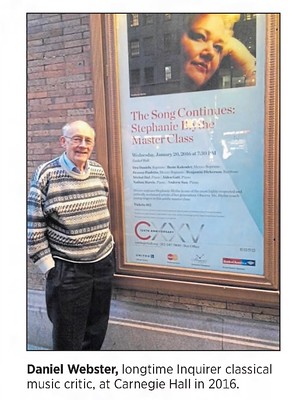 Harvey Daniel Webster was born in Grand Junction, Colorado, on February 5, 1932, the son of
Harvey L. Webster (1893-1962), a postal clerk, and Harriet Northrop Webster (1904-1989).
Harvey Daniel Webster was born in Grand Junction, Colorado, on February 5, 1932, the son of
Harvey L. Webster (1893-1962), a postal clerk, and Harriet Northrop Webster (1904-1989).
Daniel graduated from Dartmouth College and received a master's degree in journalism from Boston University.
Daniel was trained as a French Horn player. He worked at the New England Music camp in Oakland, Maine. It was there that he met Helen Theresa Sault (1920-1989). They were married in 1953 and had two sons and a daughter. Following her death in 1989, he married Karen Gripp in 1993.
He spent two years with the U. S. Army Band in Salzburg during the Korean War.
His first job was with the Newburyport (MA) Daily News followed by the Quincy Patriot Ledger. He was the classical music critic for the Philadelphia Inquirer from 1962 to 1999. In 1963 he travelled with the Philadelphia Orchestra to China in an early cultural exchange program.
His "Coins" column appeared in the January 22, 1978, issue of the Philadelphia Inquirer under the nom de plume of Henri Sault. The column ran through March 11, 2005, spanning about 27 years and two months.
The column was syndicated through Knight-Ridder. In June of 1978, the column ran in three newspapers. In 1985, the same column ran over about a month in a dozen papers around the country. When the column was discontinued in March, 2005, it was carried in five papers.
The Webster columns included stories typically seen in newspaper columns. He reported on new coin issues, auction offerings and results. He mentioned new book issues and new videos. He promoted The Counterfeit Coin Bulletin first published in 2000. When the ANA convention came to Philadelphia and to Pittsburgh, he promoted these through his column. He also promoted regional and local coin shows.
It wasn't just about coins. He frequently wrote about new medal issues and changes in paper money. And it wasn't just about American cons. He mentioned new issues of world coins.
With his base in Philadelphia, he reported news from the U. S. Mint in Philadelphia. When Augustine A. Albino was promoted to Mint Superintendent in 1997, Henri Sault wrote an article about him. When there was an exhibition about Philadelphia sculptor and medalist Gilroy Roberts opening at the American Numismatic Society, he was mentioned.
Webster generally wrote about current events. There were occasional columns on historical coins, but they were few. His readers could learn much of what they would get by subscribing to a coin paper, but without the ads.
Webster died at home in Wilmington, Delaware, on May 13, 2018.
To read the earlier E-Sylum article, see:
ROGER BOYE
(https://www.coinbooks.org/v27/esylum_v27n36a17.html)
ATLAS NUMISMATICS SELECTIONS: SEPTEMBER 15, 2024
Atlas Numismatics has updated their website with 589 new coins, medals, and tokens at fixed prices. Selections include the following items: -Garrett
1080330 | ROMAN IMPERIAL. Hadrian. (Emperor, 117-138 AD). Struck 134-138 AD. AV Aureus. NGC Ch. AU? (Choice About Uncirculated ?) Strike 5/5 Surface 5/5 Fine Style. Rome. 7.31gm. HADRIANVS AVG COS III P P. Bare-headed and draped bust right / Hadrian. Aureus. 134-138 AD. Rome. "Travel series" issue. (Ric-II.3, 1562). (Calicó-1176a). Anv.: HADRIANVS AVGVSTVS. Bare-headed and draped bust right. Rev.: ADVEN-TVI AV-G ITALIAE. Hadrian, togate, standing left raising right hand and holding roll, facing Italia holding cornucopiae and sacrificing out of patera over garlanded altar. RIC II.3, 1562; Calicó 1176a. "Travel series" issue.
Ex Numismatica Genevensis SA, Auction 10 (3 December 2018) Lot 43.
$79,500
To read the complete item description, see:
Exceptional "Travel Series" Aureus of Hadrian
(https://atlasnumismatics.com/1080330/)
1079786 | CZECHOSLOVAKIA. Republic. (1918-1939). 1934 AV 10 Ducats. NGC MS68. By J. Benda (Obv.) & O. Spaniel (Rev.). Kremnitz. Edge: Milled. REPUBLIKA CESKOSLOVENSKÁ. Czech lion with Slovak shield, denomination and date below /NEDEJ·ZAHYNOUTI·NÁM·I·BUDOUCÍM/ +929/ B-O·Š . Duke Wenceslas (Vaclav) on horseback right. KM 14; Fr.-4; Schlumberger 32; Novotny 19. 1298 pieces minted.
$89,500
To read the complete item description, see:
Superlative Czech 10 Ducats
(https://atlasnumismatics.com/1079786)
1079307 | FRANCE. 2nd Republic. (1848-1852). 1848 AV Essai 20 Francs. NGC PR64 Cameo. By E. Farochon. Paris. REPUBLIQUE FRANÇAISE. Laureate head, right. Level to the left, dove to the right, clasped hands below / Denomination and date within wreath. Mazard 1249; Guilloteau 3024.
$19,500
To read the complete item description, see:
Essai 20 Francs in Gold
(https://atlasnumismatics.com/1079307)
1079674 | GERMAN STATES. Bavaria. Luitpold. (Prince Regent, 1886-1912). 1891 AR Medallic Double Thaler. PCGS SP64. By A. Börsch. 41mm. 34.40gm. Bust, left / View of the bridge. Gebhardt 201; Hauser 598; Witt.-3063. On the construction of the Luitpold Bridge in Munich.
$795
To read the complete item description, see:
Medallic Double Thaler of Bavaria
(https://atlasnumismatics.com/1079674)
1079208 | GREAT BRITAIN. England. Charles II, Peace of Breda. (1667) AR Medal. PCGS SP62. By J. Roettiers. Edge: (rose) + (rose) CAROLVS (star) SECVNDVS (star) PACIS (star) ET (star) IMPERII (star) RESTITVOR (star) AVGVSTVS (Charles II, august restorer of peace and of the empire). 56mm. 74.68gm. CAROLVS · SECVNDVS · DEI · GRATIA · MAG · BRI · FRAN · ET · HIB · REX. Laureate head right / FAVENTE DEO (By God's favor). Britannia seated left on rocky outcropping, beside hill, head turned toward fleet of ships in background, holding filleted spear in right hand and resting left hand on Union shield; in background to left, ship under sail left with fleet in distance, personification of the sun above; BRITANNIA in exergue. Van Loon II p. 522; MI 535/186; Eimer 241.
Includes original collector's envelope.
$7,500
To read the complete item description, see:
Beautiful Peace of Breda Medal
(https://atlasnumismatics.com/1079208)
1080058 | GREAT BRITAIN. George III. (King, 1760-1820). 1820 AV Sovereign. PCGS PR64DCAM (Deep Cameo). GEORGIUS III D.F. BRITANNIAR. REX F.D. Laureate head right / St. George slaying the dragon right. KM 674. Proof; SCBC-3785C; Friedberg 371; WR-200 (Rarity 7, 1-2 known). Exceedingly rare date in proof; frosted devices and mirrored fields.
Ex. Bentley Collection, Baldwin's Auction 76 (27 September 2012) Lot 385; Ex Sothebys, (17 November 2000) Lot 525 (part), illustrated as No.7.
Price upon request.
To read the complete item description, see:
1820 Proof Sovereign
(https://atlasnumismatics.com/1080058)
1079852 | GREAT BRITAIN. Victoria. (Queen, 1837-1901). 1885 AR Gothic Florin, Two Shillings. NGC MS61. Queen in crown and decorated dress, legend in Gothic script; Without die number / Crowned shields of England, Scotland and Ireland in cross formation with flowers at corners. KM 746.4; SCBC-3900. Superb "bull's eye" toning most often associated with paper board storage.
$1,495
To read the complete item description, see:
Colorful "Gothic" Florin
(https://atlasnumismatics.com/1079852)
1079044 | SWISS CANTONS. Basel. 1740 H (Johann Jakob Handmann, Mintmaster) AV Pattern or Off-Metal 3 Ducats. PCGS MS63PL (Prooflike). 10.40gm. Eight shields above BASILEA over city view / Basilisk holding shield. KM Pn8; Fr.-64; Richter (Proben) 1-65; D.T. 768; cf. HMZ 2-102c. Struck with 1/4 Thaler dies, KM#144; Richter lists under Proben (patterns). Superb prooflike surfaces and exceedingly rare.
$98,500
To read the complete item description, see:
Basel City View 3 Ducats
(https://atlasnumismatics.com/1079044)
Updates to their online inventory are issued monthly.
For more information and to sign up for the firm's monthly newsletter, visit: atlasnumismatics.com
VILA RICA MOEDAS AUCTION 22
Vila Rica Moedas of São Paulo, Brazil is holding their 22nd auction this week - here's the press release. Some great coins and archival material here. -Editor
 Vila Rica will hold its Auction 22 on September 17th and 18th. The auction is internet-only and split over two sessions. It will offer a vast range of Brazilian coins, from Colonial to Republican issues, foreign coins, literature, and a collection of rare receipts of colonial gold bars. It also features the most important coin of all copper coinage, the 80 Réis 1831B.
Vila Rica will hold its Auction 22 on September 17th and 18th. The auction is internet-only and split over two sessions. It will offer a vast range of Brazilian coins, from Colonial to Republican issues, foreign coins, literature, and a collection of rare receipts of colonial gold bars. It also features the most important coin of all copper coinage, the 80 Réis 1831B.
During the first half of the 18th century, Vila Rica (now Ouro Preto) and the other cities in the Minas Gerais District of Brazil produced half of the world's gold output. Gold coins and gold bars were produced in abundance, and due to their high metal value (some bars weighed more than 200 grams), very few bars survived, with most having been melted down over the last 300 years.
Gold in powder or nuggets were brought to a foundry house, controlled by the crown. The gold was melted, tax was applied, and the net result was returned to the owner in the form of a bar, punch marked with information such as number, weight, fineness, assayers' initials, date, mint mark, etc. Each bar was accompanied by its own guide which recorded the same information marked in the bar, for the purpose of attesting authenticity and checking the bar´s specifications. The foundry house kept a copy in the form of a receipt in its books. Bars, guides and receipts are therefore very important numismatic documents that are rarely offered on the market and are very sought after by collectors. The collection that we are auctioning has been built up over the last 25 years and this sale is a unique opportunity to acquire such pieces, themselves extremely important documents from one of the greatest cycles of gold discovery and exploration in history.
Some highlights of the sale follow:
Lot 11 - Brazil, 6400 Réis, 1832R. Gold. AI O612. VF+. With die artist name's AZEVEDO F. Rare! Very little circulation and the condition isn't better due to some marks on the reverse. Lightly cleaned but still retaining some original luster
Lot 14 - Brazil, 20000 Réis, 1862. Gold. AI O682. NGC AU50. Key date of the series! Extremely rare
Lot 16 - Crowned Stamp, 2S0 (250) Réis, ND (1688). Silver. AI P093; Bentes 62.02 (R2). VF+. Over Portuguese 1/2 cruzado D. João IIII - Évora (with new border, legend and cord). Beautiful coin, very attractive. Very rare for being Évora
Lot 18 - Brazil, 320 Réis, 1702P. Silver. AI P146; Aranha 1B (E). VF-. One of the key dates of the extensive coinage of 320 Réis and very rare in any condition. Rarely offered on the market.
Lot 293 - Brazil, 80 Réis, 1831B. Copper. AI C660. VF, and with a beautiful dark wine color. Very attractive. With no more than 10 pieces known, the 80 Réis of 1831B is the most important piece of the copper collection. The coin offered here at auction is one of the two best preserved among those in existence (the other belonging to a private collector from Minas Gerais state). Like all the others, it shows evidence of having been minted with rusty dies. This one, however, has been fully struck, with denomination, date, mintmark "B" and all the legends struck and preserved in their entirety, which is rare for this type, which is in itself a very rare coin. We offer here a unique opportunity not only to acquire an extremely rare piece, but also one of the two best preserved.
Lot 308 - Page 124 of the Vila Rica Foundry House registry book. Registration (receipts) of bars 5281, 5282, 5283 and 5284. Year 1758. Excellent condition. Very rare lot. The few surviving bar records and guides are very rare, and this lot with the sequence of receipts of 4 bars is certainly a unique piece. Prober record 003. Prober page 23. Ex. Souza Lobo, Guinle and Prober Collections. The oldest known dates of the bars are from the end of the 18th century and this guide is, therefore, one of the only and rare records of bars cast in the 50s of that century. A buying opportunity that will not be repeated any time soon.
Lot 310 - Guide of bar 2900 from the Vila Rica Foundry. Year 1765. Prober record 005. Excellent condition and extremely rare. Ex. Kurt Prober Collection. The oldest known dates of the bars are from the end of the 18th century and this guide is, therefore, one of the only and rare records of bars cast in the 60s of that century.
Lot 314 - Guide of bar 355 from the São Félix Foundry of the Captaincy of Goyaz. Dated June 23, 1773. Unpublished and the only one known. Ref: SNB Bulletin No. 54, 2004, "Guia de Barra de Ouro Fundição de São Félix", by Cláudio Schroeder, pages 86 and 87, with illustration. According to the article, Prober reports the history of the São Félix Foundry but does not mention examples of bars or guides. According to Prober's study, this would be a type 7 guide, with text beginning with METTEO. It would have the catalog number Prober 006. Pre-printed date text 176_ but later changed, by hand, to 1773. In exceptional condition and for this reason even more exceptional. The oldest known dates of the bars are from the end of the 18th century and this guide is therefore one of the only and rare records of bars cast in the 70s. A buying opportunity that will not be repeated any time soon.
Lot 315 - Guide of bar 2650 from the Vila Rica Foundry. Dated August 7, 1798. Very rare. Ex. SNB Auction - December 7, 2008, VI Latin American Numismatic Congress, lot 234 (sold for R$ 2,000.00 = US$ 1,000.00); Ex. Roberto Lemos Monteiro Collection; Ex. Private Collection. In exceptional condition and very rare as such. It comes with original plastic auction envelope, a clipping of the lot's photo from the auction catalog with notes by Dr. Roberto, and a card with a description of the guide, handwritten and signed by Dr. Roberto. Provenance from one of the most important numismatic collections of Brazil.
Lot 317 – Empty / Unfilled gold bar guide, without handwritten notes! Unpublished and extremely rare. See Prober page 25
Vila Rica Moedas (www.vilaricamoedas.com) is a Numismatic company based in São Paulo, Brazil, and it is run by its two partners David André Levy and Hilton Lúcio, both authors of reference catalogs and accomplished numismatists.
The auction will take place on September 17th and 18th. Registration for bidding can be done at https://leiloes.vilaricamoedas.com/. If you need assistance, please feel free to contact either David or Hilton through the email info@vilaricamoedas.com and they will be happy to assist you with registration.
STACK'S BOWERS DICK JOHNSON MEDAL SELECTIONS
Here are some medals in the upcoming Stack's Bowers sale of the Dick Johnson collection. Some great pieces here. -Editor
1907 Great White Fleet Departure Plaque. Failor-Hayden 532. Bronze. Mint State.
1905 39th Annual Encampment of the Grand Army of the Republic in Denver, Colorado Medal.
Undated (ca. 1857) Tomb of Washington Medal. By Smith and Hartmann. Musante GW-207, Baker-117A. Bronze. Mint State.
1900 Hall of Fame for Great Americans Medal. Baker-E356A. Red Bronze. Mint State.
"1809-1865" Illinois Watch Company Lincoln Essay Medal. Cunningham 19-140Bz, King-892. Bronze. Mint State.
1900 Katrina Trask Portrait Medal. Uniface. By Victor David Brenner. cf. Smedley-76, Baxter-130, Marqusee-78. Bronze Galvano. Essentially As Made.
To view the auction lots, see:
https://auctions.stacksbowers.com/auctions/3-1C4EZZ/september-2024-collectors-choice-online-auction-the-dick-johnson-collection-lots-94001-94166
CARLISLE-MINTED COIN OF DAVID I OF SCOTLAND
This Noonan's press release describes a rare medieval coin offered in their upcoming sale. -Editor
A unique and unpublished coin from the reign of David I of Scotland (1124-1153) that was minted in Carlisle is to be offered by Noonans Mayfair on Thursday, September 19, 2024 in a sale of British, World Coins and Historical Medals. It is estimated at £15,000-20,000 and is being sold by the finder.
As Jim Brown, Coin Specialist at Noonans explains: "This is a find of considerable historical and numismatic importance. It is not really surprising that new varieties of medieval coins turn up from time to time - this is to be expected. What makes this find so different is the unique nature of the design - a complete and totally unexpected departure from the norm."
He continues: "The original medieval fortress at Carlisle that was constructed in 1092, after the capture of the city from the Scots by William Rufus. Some 30 years later, Henry I decreed it be rebuilt in stone and ‘fortified with a castle and towers'. This is probably the medieval keep that can be seen today, albeit much altered in the interim."
As Mr Brown adds: "The exact occasion of its striking however can only be surmised. It was a tumultuous period of alliances, battles and treaties changing with the ebb and flow of the political and military struggle. In view of the obverse type, it may be to commemorate David's fortification of his new power base in Cumbria - an issue unparalleled in British medieval numismatics."
The death of Henry in France on 1 December 1135 altered his kingdom forever and initiated the Anarchy, a period of unrest played out around the disputed succession to throne between Henry's daughter Matilda and her cousin Stephen of Blois. Although the barons of the land had agreed to recognise Matilda, Stephen, on hearing of Henry's death, was quicker to return to England to stake his claim and was crowned in Westminster Abbey on 22 December. Within a matter of days, David I of Scotland began an invasion of the north of England, ostensibly in support of Matilda who was his niece but more likely seeing an unexpected and unrivalled opportunity to regain territory in the disputed borderlands between the kingdoms.
Carlisle fell to the Scots before the end of January 1136 and possession was ratified by the first Treaty of Durham a few months later. David was quick to continue the fortification of the castle begun by Henry a decade earlier. According to Oram, Carlisle was one of David's favourite residences and he spent a great deal of time there. He died in his bedchamber in the tower of the castle in late May 1153.
The discovery of silver deposits near Carlisle in the 1120s led to the swift establishment of a mint where coins were struck of Henry I types XIV and XV. In the new reign, production of type I coinage continued, in Stephen's name, after the capture of the city by the Scots. This issue would have begun soon after Stephen's accession at Christmas 1135 and is generally considered to run until c. 1141-2. The moneyers were Erembald, Udard and Wilealme. Some pennies were produced in the name of David while retaining the familiar portrait style and reverse type. Erembald was again one of the moneyers - some of his coins also bearing an Edinburgh mint signature. It is during this period that the present coin would have been struck.
For more information, see:
https://www.noonans.co.uk/
THE BOOK BAZARRE
LENHAM HOARD OF IRON AGE GOLD STATERS
Another Noonan's press release highlights the Lenham hoard of Celtic gold staters. -Editor
A collection of 35 gold coins or staters that were discovered during a rally in Kent in August 2022, along with nine fragments of a flint nodule, that has been reconstructed, are expected to fetch an estimated £20,000 when offered by Noonans Mayfair on Wednesday, September 18, 2024.
As Nigel Mills, Coins and artefacts Specialist at Noonans explained: "It was Friday, August 26th 2022, the opening morning of the Joan Allen Detecting Rally – a regular event in Kent, that Tony Asquith, along with many other detectorists were hoping to find something of interest!"
He continued: "Using his Minelab Equinox 800, Tony at first just found some wire and a shotgun cartridge. But then, he got a signal which revealed a brownish coin. He was surprised to recognise this as a Celtic stater. On looking down he saw what looked like a pile of chocolate buttons laid out. Putting on his glasses, Tony realised that they were all Celtic staters!
Tony, who is retired and has been detecting for over 45 years, said: "It was amazing! The recent ploughing of the field must have brought the nodule to the surface, and broke it open, scattering its contents of coins."
 Mr Mills added: "The staters date to around 55BC after Julius Caesar had conquered Gaul and
attempted to invade Britain. They all have a shallow domed obverse with a dished reverse that
displays an abstract or devolved horse galloping to the right with a charioteer's arm above. The
coins were concealed within the flint nodule which was formed 90-70 million years ago. The
hollow interior would originally have contained mud and the decayed remains of marine
animals. 10 other hoards of Iron Age gold coins contained in flint nodules have been found in
Britain, but all of them are in museums"
Mr Mills added: "The staters date to around 55BC after Julius Caesar had conquered Gaul and
attempted to invade Britain. They all have a shallow domed obverse with a dished reverse that
displays an abstract or devolved horse galloping to the right with a charioteer's arm above. The
coins were concealed within the flint nodule which was formed 90-70 million years ago. The
hollow interior would originally have contained mud and the decayed remains of marine
animals. 10 other hoards of Iron Age gold coins contained in flint nodules have been found in
Britain, but all of them are in museums"
For more information, see:
https://www.noonans.co.uk/
SOVEREIGN RARITIES AUCTION XIV
Here's a press release with highlights from the upcoming Sovereign Rarities Auction XIV. -Editor
On Tuesday 24th September Sovereign Rarities is proud to present Auction XIV. The auction is online now, and open for pre bidding on our website www.sovr.co.uk as well as Numis24, Numisbids, Biddr and The Saleroom. Auction XIV will open with a small but high-quality selection of ancient Greek and Roman coins, some with venerable provenances dating back to the 60's. Of particular note is the gold Claudius Aureus, featuring an excellent portrait and Pax-Nemesis reverse, graded by NGC as CH XF 4/5 2/5 (lot 7).
These are followed by a larger collection of highly graded Byzantine Solidi including a Justin II gold Lightweight Solidus of 22 Siliquae awarded a grade by NGC of XF 4/5 4/5 (lot 20).
The British section commences with three Celtic Coins, which are followed by a broad selection of rare to extremely rare Anglo-Saxon pennies; including an Archbishops of Canterbury, Wulfred silver Penny (lot 46), a particularly charming Canute short cross Guildford mint (lot 54), and an Edward the confessor small flan type hailing from the Tamworth mint (lot 59). There are several further mints and types represented within the sale.
This then graduates into our English and Anglo Gallic Hammered coins, from the reigns of Edward III to Charles I, including an extremely rare Sovereign of Elizabeth I, with mint mark hand (lot 79) it has been awarded a grade of XF40 by NGC, roughly eight known of this type and mintmark combination.
The English milled section contains a comprehensive selection of gold, silver, copper, and bronze coins, including a Charles II gold broad of 20 shillings dated 1662 with much eye appeal, graded by PCGS as MS61 (lot 85). The auction also features a George III 1820 copper pattern Crown (lot 122) recorded by NGC as PF62 BN. The modern section boasts a selection PF70 graded Elizabeth II coinage, including an Elizabeth II 2002 gold proof Maundy Set (lot 278) with each coin slabbed and graded by NGC as PF70 Ultra Cameo.
The World section is particularly interesting, with high grade Austrian, Bulgarian and Romanian coinage, and includes a stunning USA gold proof three dollar which is graded by PCGS as PR66+ Cameo and CAC endorsed, with a mintage of only 291, tied for finest known grade (lot 368).
Closing the sale will be a selection of commemorative medals to including a rare Robert Devereaux silver-gilt military reward 1692 (lot 372) and the whimsical Pablo Picasso Visage Geometrique aux traits gold Medallion crafted in 23 carat gold, numbered 6 of 20 (lot 381).
The auction will be held live in our Mayfair office on the 24th September and will commence at 10:30am BST.
TCNC 2024 MILITARIA & HISTORICAL MEDAL SALE
The Canadian Numismatic Company is holding its inaugural Militaria and Historical Medal Sale. Here are some selections. -Garrett
Welcome to the 2024 Militaria & Historical Medal Sale Event. This is the first ever sale of this type held by us consisting of only Militaria and Medal type lots, and we would like to share our gratitude with all the consignors that entrusted us with their superb collections which permitted us to do such a sale. This four session Sale of approximatively 1025 lots will highlight the cumulation of 2 major collections. Included is the highly anticipated Part 4 of the Militaria Collection & Part 1 of the Marelic Collection of Leroux and Breton Medals and Medallions. These collections, along with several other private issues, present a wonderful assortment of pre-WW1, WW1, WW2, and post-war medals, medallions, tokens, and more.
Militaria Medal; Canadian Military General Service Medal w/Chateauguay clasp to "J.B. VEILLIEUX. CANADA MILITIA". Served with the Lower Canada Militia. Considered to be one of the rarest military medal/clasp pairing. A similar example sold in our 2024 New Years Sale for $15,535,00.
To read the complete item description, see:
Canadian Military General Service Medal With Chateauguay clasp
(https://auctions.canadiancoinsandpapermoney.com/auction/231/the-militaria--historical-medals-sale/session/471/lot/1)
Militaria Medals; Canadian Grouping of 3 Medals to ''633580 SPR. L.A. MCKINNON. CAN:E.'' includes 1914-18 British War Medal, Victory Medal & The For Distinguished Conduct on the Field Medal. Documentation belonging and pertaining to Sapper McKinnon included in the lot.
To read the complete item description, see:
Distinguished Canadian Medal Lot
(https://auctions.canadiancoinsandpapermoney.com/auction/231/the-militaria--historical-medals-sale/session/471/lot/24)
Militaria Medal; Rare Canadian Husband & Wife Grouping of WW1 Medals. Includes 1914-15 Star to ''CAPT. E.C. WINDELER. R.CAN:H.ART:'' 1914-18 British War & Victory Medal to MAJOR E.C.H. WINDELER. Same grouping 1914-15 Star to ''N. SISTER J. JOHNSTON. CAN:A.M.C.'', 1914-18 British War & Victory Medals to ''N. SISTER. J. JOHNSTON.''. A rare and intriguing grouping with extensive bios and pictures for both attached.
To read the complete item description, see:
Rare Canadian Husband and Wife Medal Grouping
(https://auctions.canadiancoinsandpapermoney.com/auction/231/the-militaria--historical-medals-sale/session/471/lot/57)
Militaria Medals; Canadian Grouping of 7 Medals to ''ERIC OSCAR KEELING'' includes Military Cross, 1914-18 British War Medal, Victory Medal both to his Capt.'s rank, 1939-45 Volunteer Medal, 1939-45 War Medal, Colonial Auxiliary Forces Decoration to Lt. Colonel's rank & The Geo V For Long Service in the Colonial Auxiliary Forces Medal to Major's rank. A superb assembly of medals with documentation on hand.
To read the complete item description, see:
Lieutenant Colonel's Grouping of 7 Medals
(https://auctions.canadiancoinsandpapermoney.com/auction/231/the-militaria--historical-medals-sale/session/471/lot/61)
Medals; 1920 Hudson's Bay Company Twenty Years Faithful Service (T1) Medal w/2 x FIVE YEARS clasps. Attributed and inscribed to '' F.A. CRACKNELL FOR 30 YEARS FAITHFUL SERVICE'' w/date 1935. Rare 9kt (,375) Gold example housed in Original Case. First ever Gold example offered by us. Should be considered quite scarce.
To read the complete item description, see:
Hudson's Bay Company Twenty Years Faithful Service Medal in Gold
(https://auctions.canadiancoinsandpapermoney.com/auction/231/the-militaria--historical-medals-sale/session/483/lot/822)
Medal; Lansdowne. Governor General - The Marquess of Lansdowne Gold Medal, 1884. AV, 18K, 104.3 gm (2.51ozs), 51mm, by J.S. & A.B. Wyon. Cl 104. Conjoined busts of the Marquess and Marchioness of Lansdowne facing right, inscription around; Rx: Helmeted and supported arms of Lansdowne, inscription around. Unawarded. Edge plain. aEF, reflective fields, hdlg and hairlined, cpl marks on the male's chin; few rbs and edge marks. Housed in a cream velvet lined green leather box (sl wear). Rarely offered. Ex Max Brail Collection.
To read the complete item description, see:
The Lansdowne. Governor General - The Marquess of Lansdowne Gold Medal
(https://auctions.canadiancoinsandpapermoney.com/auction/231/the-militaria--historical-medals-sale/session/483/lot/823)
Leroux Medal; Leroux-866 Upper Canada Preserved/Presented by a Grateful Country. For Merit Medal - housed in original case. 51,29mm, 71,3 gr. Original medals were struck in celebration of British victories during the war of 1812 against the Americans. Stamped 22 on edge w/only 100 struck by Wyon. Nice example with a touch of yellow peripheral lustre.
To read the complete item description, see:
Leroux-866 Upper Canada Medal
(https://auctions.canadiancoinsandpapermoney.com/auction/231/the-militaria--historical-medals-sale/session/483/lot/835)
We are extremely proud to present a superb catalogue and sale that should be viewed thoroughly and we hope you enjoy your journey through these important yet turbulent periods which helped to establish North America and Europe as we know it today. Again, We hope you enjoy this catalogue as much as we enjoyed making it. This should be a memorable sale!
STACK'S BOWERS 2024 MAASTRICHT AUCTION
Here's a press release about offerings in Stack's Bowers' upcoming Maastricht Auction of World Paper Money. Some nice notes here. -Editor
Stack's Bowers Galleries is pleased to announce the release of the catalog for its highly anticipated Maastricht Auction, held in conjunction with the MIF Paper Money Fair. This auction promises to be one of the most diverse and extensive ever presented by the firm, showcasing a range of highlights and rare items from around the world.
As the main sponsor and official auctioneer of the event, Stack's Bowers Galleries commends the supporters and participants who have contributed to the ongoing success and expansion of this prestigious venue. "Advancing the hobby of numismatics is a collective endeavor, reliant on the efforts of the entire community," noted Aris Maragoudakis, Director of World Paper. "The bourse floor has become an incredibly positive environment, and it is wonderful to see everyone at each show working together and experiencing the event as one."
The Fall 2024 Maastricht Auction features another significant installment from the esteemed Al Kugel Collection, offering over 80 lots with rare and sought-after items from regions such as China, Danzig, Estonia, German East Africa, Latvia, Lithuania, Norway, Russia, Tannu Tuva, and more. Of particular note is the highly coveted Finnish/Russian Olenets set from 1918, presented in lot 20738. Additionally, there are unique pieces from Lietuvos Ukio Bankas, such as the 50, 500, and 1000 OST Markiu from the 1919-20 series (lots 20549, 20550, and 20551). The collection also encompasses treasures from the Deutsch-Asiatische Bank: the Narodna Banka Kraljevine Jugoslavije with 500 and 1000 Dinara specimens in lots 20845 and 20847, as well as the unissued and sole graded 1943 500 Dinara in lot 20486. Also notable are the 1919 Chaikovskiy Government overprinted 100 Rubles (lot 20736) and 500 Rubles (lot 20737), which underscore this as the premier Kugel offering to date.
Also presented are key specimen collections from countries with high collector demand, such as the Mombasa Collection of East African high denomination specimens and the Pharaoh Collection of Egyptian notes. Numerous printer's models and essays include Qatar's 500 Riyals Printer's Models in lot 20706 and a 1974 20 Dollar Printer's Model from the Bahamas in lot 20050.
Among other standout items are an Iceland CU64 100 Kronur from 1927 in lot 20394, the Saar 1947 100 Mark in gem condition in lot 20741, and a 2015 Pudsey Bear 5 Pound note from Scotland in 67EPQ in lot 20762. Highlights from India include the R6 100 Rupees in lot 20437 and a rare P-9l 50 Rupees in EF 40 in lot 20413. A 1929 Color Trial 500 Thalers from Ethiopia in lot 20283 and a 10 Thalers Color Trial from the Bank of Abyssinia in lot 20280 add to the auction's diverse offerings.
Enhancing the catalog are QR codes linked to videos and blog posts providing further details on select lots. Stack's Bowers Galleries is committed to delivering the highest quality and most collector-focused auction experience possible. Aris Maragoudakis went on to note, "Adding Dennis Hengeveld to our team has allowed us to focus even more on delivering the best possible product. Fusing our collective knowledge with Dennis's passion as a long-time collector, has enabled us to take our descriptions a step further. The added support provides more operational power, and we can feature additional elements in our catalogs that collectors have been waiting for."
"This sale promises to be one of the best in the firm's history," stated Dennis Hengeveld. "Countless times while cataloging, I have been amazed with what was before me. I am certain there will be spirited bidding among collectors, many of whom have waited a long time for a crack at some of these treasures."
The MIF Paper Money Fair will be held in Maastricht at the MECC from September 27-29. The Stack's Bowers Galleries Auction will be held the following week, with the main session on October 2 at 7AM PDT and Part II of the Virginia Judge's Collection of World Paper Money on the following day, October 3 at 9AM PDT.
For further information on Stack's Bowers Galleries Fall 2024 Maastricht Auction and to view the catalog, please visit www.stacksbowers.com. To consign to one of the firm's upcoming auctions contact Director of World Paper Aris Maragoudakis at Aris@StacksBowers.com.
VIKING KING ATHELSTAN II SILVER PENNY FOUND
A rare silver penny of Viking King Athelstan II has been discovered in England. -Garrett
A rare coin minted by a Viking warlord after he became a Christian king is "the first in the country" to benefit from a new Treasure Act definition on "the basis of national significance", an expert has said.
The silver penny was made for Athelstan II, better known as Guthrum, who led a Danish invasion of Anglo-Saxon England and waged war against Alfred the Great.
He converted to Christianity as part of a peace deal and when he withdrew to run East Anglia as his own kingdom in AD 880, began minting his own coins.
The Athelstan II temple-type penny was discovered by a metal detectorist near Thetford, Norfolk, earlier this year and is the subject of a treasure inquest.
To read the complete article, see:
Viking king's coin find of 'national significance'
(https://www.bbc.com/news/articles/cg79e45341po)
ROWER'S FOUR OLYMPIC MEDALS STOLEN
Aaron Oppenheim passed along this sad story of the theft of an Olympian's four medals. Thanks. -Editor
Police have arrested and charged a man for allegedly stealing four Olympic medals belonging to Australian rower Drew Ginn. But the medals – three gold and a silver – are still missing.
The 47-year-old man, who was wanted on a warrant over the alleged theft, was arrested on Wednesday in Brunswick, a northern suburb of Melbourne. Authorities said Ginn's medals were believed to have been stolen from the back of a Land Rover parked in the Victorian capital about a week ago.
Ginn is one of Australia's most decorated Olympic athletes and was a member of the champion rowing crew known as "The Oarsome Foursome."
He won the medals during a nearly two decade Olympic career that began at the 1996 games in Atlanta and continued through to the London Olympics in 2012.
The 49-year-old voiced hope that, rather than being sold, the medals might find their way back to their rightful owner.
To read the complete article, see:
Four Olympic medals stolen from Australian rower's car
(https://www.cnn.com/2024/09/11/sport/australia-drew-ginn-olympic-medals-stolen-intl-hnk/index.html)
ARGENTINE PROVINCE LAUNCHES OWN CURRENCY
Kavan Ratnatunga passed along this article about a rogue province in Argentina that has issued its own currency in response to the country's shambolic economy. Thanks. -Editor
There are few places in all of Argentina as poor as La Rioja, a sleepy, desolate province carved out of the red-clay highlands that form the country's northwestern border with Chile.
And it is here, in La Rioja, that the financial toll of President Javier Milei's shock economic therapy — a high-stakes bid to tame chronic inflation — can best be observed. When Milei slashed the monthly cash transfers from the federal government to the provinces, La Rioja went broke. In February, it fell into default. And soon the local economy had sunk into a deep recession.
So the governor, an outspoken critic of Milei by the name of Ricardo Quintela, dialed up a radical plan of his own. He created the province's own currency, the chacho, had sheets of it printed up and started doling it out in wads of 50,000 to all government employees. It was a little bonus payment, Quintela said, to help people buy more of the essentials they'd been skimping on. Shop owners weren't outright forced, but rather strongly encouraged, to accept chachos just like they would pesos. One chacho equals one peso.
On a chilly morning in late August, the province's workers bundled up in heavy jackets and hurried to get into line to collect their new currency. There was some grumbling as morning turned to afternoon and the line crawled along at a glacial pace — "seven hours to collect 50,000 filthy chachos," one groused — but the mood was generally light. They made small talk and sipped mate. The payment they were due, equal to some US$40, was a lot of money in a province where the average monthly salary is just US$240.
Chachos finally in hand, they wasted no time in spending them.
At Refinor, a gas station in the provincial capital city, business jumped 10 percent that morning.
Quintela has pointed merchants eager to get rid of their chachos to the two government offices in the capital city that will, after a 48-hour mandatory wait, exchange them for pesos. Wait all the way till December, Quintela has told them, and the provincial government will pay them 1.17 pesos for each chacho, effectively an interest rate of 17 percent in pesos that, when annualised, comes to over 50 percent.
Ángel Vicente ‘Chacho' Peñaloza is a legend around here. Monuments to him dot the landscape. In most of them, Chacho, a fierce local caudillo who, fittingly, made his name fighting against forces from Buenos Aires during the 19th-century civil wars, strikes a menacing pose, spear slung over his shoulder, as he commands his troops.
This is the rugged image that adorns the new bills. There's also a QR code on each bill which, when scanned, displays a sharply worded message blasting the Milei government for starving the province of the federal funds it's due.
The chachos come in denominations of 1,000 to 50,000.
As I often point out, the best time to collect numismatic items such as these is always NOW, while they are in use and plentiful. Social media makes it easy to contact individuals around the world - no need for intermediaries like traveling clergy or the U.S. State Department. Assuming there are no sanctions against Argentina, what would you have to lose? -Editor
To read the complete article, see:
‘Los chachos': La Rioja launches currency to offset Milei's shock therapy
(https://www.batimes.com.ar/news/economy/los-chachos-la-rioja-launches-currency-to-offset-mileis-shock-therapy.phtml)
JEFF GARRETT ON SHARING YOUR COLLECTION
This article from NGC's eNewsletter, written by Jeff Garrett, covers famous collections that have been made available for public viewing as well as how all collectors can share their numismatic items and knowledge. -Garrett
One of the highlights of the recently completed 2024 ANA World's Fair of Money was the exhibit of the Egyptian portion of the "Tyrant Collection." The collection is billed as the world's most valuable private coin collection, and for anyone who has seen this magnificent assemblage, it would be hard to dispute. The ANA show exhibit focused on Egyptian coinage starting with coins from antiquity and continuing chronologically through the Islamic period.
Besides being worth hundreds of millions of dollars, what truly makes the "Tyrant Collection" special is that O'Dowd has gone to so much effort to share his collection with the public. He has invested hundreds of thousands of dollars to showcase his collection in exhibits at coin conventions around the United States. His exhibit cases are state-of-the-art, and each is accompanied by an exhibit catalog. The collection of his exhibit catalogs is destined to be important collector items for future numismatists. The chronicling of this seminal collection is an amazing contribution to numismatics.
Obviously, O'Dowd sees value in expending so much time and money to share his collection with others in the numismatic community. Perhaps his exhibits will inspire others to explore numismatics more carefully. The "Tyrant Collection" also exposes areas of the hobby that many have never considered. Regardless of his true intentions, growing the hobby is a natural result of his efforts and should be applauded by everyone.
Not all great collectors of the past shared their mega collections so freely. The infamous collector and dealer John J. Ford Jr. never shared his giant collection with other collectors. After he passed, Stack's Bowers sold his massive collection, the catalogs for which take up nearly the entire shelf of a bookcase in my office. One dealer related to me that when the collection was picked up for auction, some of the safety deposit boxes had not been opened for decades. Ford was also stingy about sharing numismatic knowledge about his collection, instead choosing to safeguard the information for his own use.
One of the greatest collections ever assembled was the Louis Eliasberg collection that was billed as the only complete set of US coins ever put together. According to articles in the numismatic press in the 1970s, Eliasberg exhibited the collection in 1976 to help celebrate the nation's bicentennial. The public was able to see the complete story of US numismatics in one exhibit, which must have been truly a sight to see. By 1982, portions of the collection were auctioned by Stack's of New York City.
Another famous collector who enjoyed sharing his collection was the ever-enthusiastic John Jay Pittman. I have fond memories of seeing highlights of his stellar collection on exhibit at major shows such as the ANA and FUN conventions. Pittman was a famous collector of early Proof US coinage, which he pioneered the appreciation of. I remember looking at his two-coin set of Proof 1854 and 1855 Gold Dollars in amazement. Years later, I had the opportunity to handle each of the coins.
You do not have to be a billionaire to share your numismatic passions. Many major coin conventions have numismatic exhibits of every shape and size. The recently completed ANA World's Fair of Money featured an outstanding exhibit section this year with over 250 showcases. Collectors young and old shared their numismatic passion and competed for ribbons.
For our local coin club in Lexington, Kentucky, collectors often perform a "show and tell" of their prized possessions. Many of the attendees claim this is their favorite part of the monthly meetings. The numismatic camaraderie and education created by these local collectors is admirable.
Eliasberg was before my time, but I was lucky to be able to meet John Pittman, John Ford and other major collectors of the 20th century, including Jules Reiver. Ford was a top-level numismatist with deep knowledge, but he never exhibited and only selectively shared his great information bank. I often met Pittman in the exhibit area of an ANA convention, where we were both either setting up or taking down our exhibits. He was rightly a very proud owner of many amazing coins. Jules Reiver was quite welcoming, and I often met him and his wife Iona at their home when visiting Wilmington, DE. We spent hours looking over coins from his collection and I loved hearing his stories.
Please do follow the leads of Eliasberg, Pittman and Reiver whatever the size of your collection - you have great material and stories to share with fellow collectors, particularly the next generation. -Editor
To read the complete article, see:
Jeff Garrett: Sharing Your Coin Collection
(https://www.ngccoin.com/news/article/13229/)
VIRGINIA SPORTS MEMORABILIA GOLD MINE
As collectors, we can't help but relate to fellow collectors of other things, and be both happy and jealous when one of them lives the collector's dream of uncovering a hidden treasure. This New York Times article reveals a businessman's purchase of a massive collection of sports cards and memorabilia. -Editor
It is quite possibly the largest private collection of sports cards in the world — and probably by a wide margin. Mr. Banazek estimates that it includes 20 million cards, although other visitors have pegged the number even higher. For comparison, Paul Jones, a man in Idaho who claimed to have the largest private baseball card collection, told a local newspaper in 2020 that his holdings amounted to 2.8 million cards. The largest collection of nonsports trading cards consists of 32,809 items, according to Guinness World Records.
What makes the collection even more notable is its lack of public profile. For years, it sat in a concrete outbuilding behind a low-slung ranch house on a wooded country road.
Two members of the reclusive seller's family said that the collection had been painstakingly accumulated over more than 50 years and that the seller had "purchased whole collections from other buyers at times."
 The collection includes at least every Topps baseball set produced from 1954 to 2016, as well as roughly three decades' worth of completed sets of basketball and football cards. There are an estimated 10,000 Michael Jordan cards, 6,000 Kobe Bryant cards and 4,000 LeBron James cards. There are at least five different Babe Ruth cards, not to mention Ty Cobb, Lou Gehrig and Joe DiMaggio cards; authenticated tobacco cards of Walter Johnson, Christy Mathewson and others from the T206 and T205 set (1909 and 1911); hundreds of signed balls and bats; rolled-up sheets of uncut cards; and game-used catching gear worn by the Hall of Famer Bill Dickey.
The collection includes at least every Topps baseball set produced from 1954 to 2016, as well as roughly three decades' worth of completed sets of basketball and football cards. There are an estimated 10,000 Michael Jordan cards, 6,000 Kobe Bryant cards and 4,000 LeBron James cards. There are at least five different Babe Ruth cards, not to mention Ty Cobb, Lou Gehrig and Joe DiMaggio cards; authenticated tobacco cards of Walter Johnson, Christy Mathewson and others from the T206 and T205 set (1909 and 1911); hundreds of signed balls and bats; rolled-up sheets of uncut cards; and game-used catching gear worn by the Hall of Famer Bill Dickey.
The collection of artifacts extends well beyond sports and includes original and authenticated postcards of Marilyn Monroe from the 1950s; sealed boxes of cards from "Star Trek," "Star Wars" and Pokemon; and turn-of-the-century cigarette cards featuring images of stage actors popular at the time. Some of the collection is stored in literal shoe boxes. Other sets are sealed in their original packaging, fossilized bubble gum still sitting in packs.
Joe Marrs, an independent appraiser of card collections based in Chicago, visited Mr. Banazek's acquisition in 2022. It's not unusual for private individuals to quietly amass enormous stockpiles over decades in the hobby, he said. Still, he had never seen anything like the collection in Virginia.
Unlike the previous owner, Mr. Banazek does not shy away from publicity and is now considering ways to showcase his card heaven to a wider audience. He is teaming up with Rob Smith, a former executive at Endemol Shine who helped produce reality television programs like "Extreme Makeover: Home Edition" and "Wipeout." Mr. Smith said he had various ideas about how to showcase the collection, including taking it on a tour as an interactive exhibit, perhaps culminating with a residency in Las Vegas.
"To me, this is a perfect family-friendly thing where you can go and enjoy and see all these amazing things we have," Mr. Smith said, "as well as the history of card collecting, the history of America."
He has solicited help from various business partners, including John Skipper, the former ESPN executive, now at Meadowlark Media.
To read the complete article, see:
20 Million Cards: A Sports Memorabilia Gold Mine Uncovered in Virginia
(https://www.nytimes.com/2024/09/14/business/sports-memorabilia-collection-discovery.html)
LOOSE CHANGE: SEPTEMBER 15, 2024
Here are some additional items in the media this week that may be of interest. -Editor
There have been many articles in the popular media about the sale of the Bruun collection. It's another great story of a quite large and valuable collection that had been off the market and largely unknown until coming to light decades later - in this case, a full century. Howard Berlin sent this one. Thanks. -Editor
Part of a Danish coin collection belonging to butter magnate Lars Emil Bruun, went under the hammer in Copenhagen, initially collecting €14.8 million on Saturday.
The 20,000-piece collection had been kept off the market for a century as a stipulation of Bruun's will, forged soon after the destruction of the first World War.
The collection includes rare coins and medals from Denmark, Norway, Sweden and England dating back to the Viking age and is expected to be the most valuable non-US coin collection ever sold.
An eight-hour auction in the Danish capital saw the 286 coins on sale for the day bring in €14,820,900 (about $16.4 million), news agency Ritzau reported.
Auctioneer Stack's Bowers published data on the individual sold lots, showing one 15th century gold coin known as a "Hans Noble" fetching €1.2 million, well past the predicted sum of between €300,000 and €600,000. The auctioneers said there were only two confirmed coins of this type in museums, and no others in private hands prior to Saturday's sale.
For the "werd nerds" among us, in the above excerpt I fixed one typo found in the original article. Can you spot it? -Editor
To read the complete article, see:
Denmark: Rare coin collection goes on sale after a century
(https://www.dw.com/en/denmark-rare-coin-collection-goes-on-sale-after-a-century/a-70219680)
Another topic in the popular press is the perennial discussion of the U.S. one cent coin or "penny." This Axios piece highlights the private equity piece of the puzzle discussed in the recent New York Times article. -Editor
Private equity controls both sides of ... well, the coin.
Artazn: This is the maker of zinc "blanks" that the U.S. Mint stamps into pennies, and has been for over four decades. It has been owned by One Rock Capital Partners since 2019, via a carveout of the "process solutions business" of Newell Brands. One Rock renamed Artazn's parent company as Jadex.
Coinstar: This is the kiosk company that's become a linchpin to America's currency logistics. One source tells me that Coinstar last year recycled 14.6 billion pennies — around 4x what the U.S. Mint produced — with those coins then packaged and shipped to banks.
To read the complete article, see:
Private equity is in the middle of America's penny problem
(https://www.axios.com/2024/09/04/private-equity-penny-problem)
To read the earlier E-Sylum article, see:
THE PERPETUAL PENNY PARADOX
(https://www.coinbooks.org/v27/esylum_v27n35a23.html)
Aaron Oppenheim passed along this story of a small find of Byzantine gold coins. Thanks. -Editor
Archaeologists discovered ancient gold coins in an unexpected location during a recent excavation in Bulgaria.
The five Byzantine coins, which date back to the reign of Justinian the Great, were uncovered by archaeologists digging at a site in the northern Bulgarian village of Debnevo. The excavation was announced by Dr. Stiliyan Ivanov, an associate professor at the National Institute of Archaeology and Museum, on Aug. 27.
The village, which is close to a fifth-century fortress, has been the site of excavation projects for the past five years. But researchers were stumped when they found the coins in the remains of a 10th-century house.
To read the complete article, see:
Archaeologists stumble upon priceless gold coins in unusual location
(https://www.msn.com/en-us/travel/article/archaeologists-stumble-upon-priceless-gold-coins-in-unusual-location/ar-AA1qhGED)


